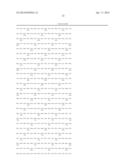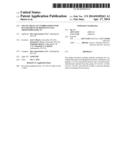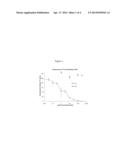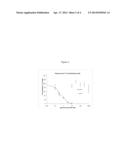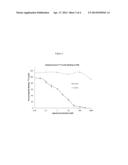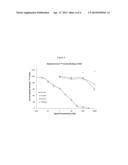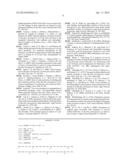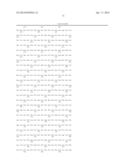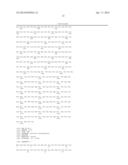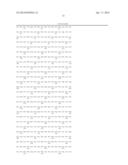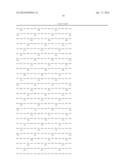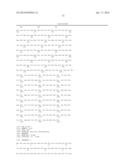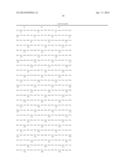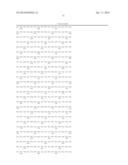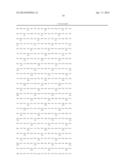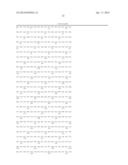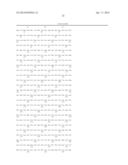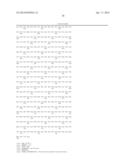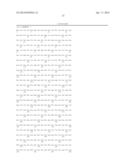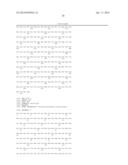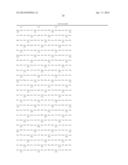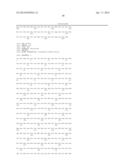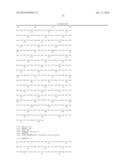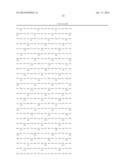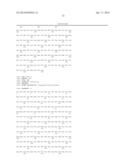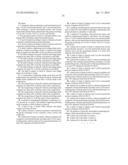Patent application title: USE OF Cry1Ea IN COMBINATIONS FOR MANAGEMENT OF RESISTANT FALL ARMYWORM INSECTS
Inventors:
Joel J. Sheets (Zionsville, IN, US)
Joel J. Sheets (Zionsville, IN, US)
Kenneth E. Narva (Zionsville, IN, US)
Kenneth E. Narva (Zionsville, IN, US)
Stephanie Burton (Indianapolis, IN, US)
Elizabeth A. Caldwell (Indianapolis, IN, US)
Assignees:
Dow AgroSciences LLC
IPC8 Class: AA01N6302FI
USPC Class:
800302
Class name: Plant, seedling, plant seed, or plant part, per se higher plant, seedling, plant seed, or plant part (i.e., angiosperms or gymnosperms) insect resistant plant which is transgenic or mutant
Publication date: 2014-04-17
Patent application number: 20140109263
Abstract:
The subject invention includes methods and plants for controlling fall
armyworm lepidopteran insects, said plants comprising a Cry1Ea
insecticidal protein and a second insecticidal protein selected from the
group of Cry1Ab, Cry1Be, Cry1Ca, Cry1Da, and Vip3Ab to delay or prevent
development of resistance by the insects.Claims:
1. A transgenic plant comprising a polynucleotide encoding a Cry1Ea
insecticidal protein, and a second polynucleotide encoding a second
insecticidal protein, said second insecticidal protein being selected
from the group consisting of Cry1Ab, Cry1Be, Cry1Ca, Cry1Da, and Vip3Ab.
2. The transgenic plant of claim 1, said plant further comprising DNA encoding a third insecticidal protein.
3. A seed of a plant according to claim 1, wherein said seed comprises said heterologous polynucleotides.
4. A seed of a plant according to claim 3, wherein said seed comprises said heterologous polynucleotides.
5. A field of plants comprising non-Bt refuge plants and a plurality of plants according to claim 1, wherein said refuge plants comprise less than 40% of all crop plants in said field.
6. The field of plants of claim 5, wherein said refuge plants comprise less than 30% of all the crop plants in said field.
7. The field of plants of claim 5, wherein said refuge plants comprise less than 20% of all the crop plants in said field.
8. The field of plants of claim 5, wherein said refuge plants comprise less than 10% of all the crop plants in said field.
9. The field of plants of claim 5, wherein said refuge plants comprise less than 5% of all the crop plants in said field.
10. The field of plants of claim 5, wherein said refuge plants are in blocks or strips.
11. A composition comprising refuge seeds from non-Bt refuge plants, and a plurality of seeds of claim 3, wherein said refuge seeds comprise less than 40% of all the seeds in the composition.
12. The composition of claim 11, wherein said refuge seeds comprise less than 30% of all the seeds in the composition.
13. The composition of claim 11, wherein said refuge seeds comprise less than 20% of all the seeds in the composition.
14. The composition of claim 11, wherein said refuge seeds comprise less than 10% of all the seeds in the composition.
15. The composition of claim 11, wherein said refuge seeds comprise less than 5% of all the seeds in the composition.
16. A method of managing development of resistance to a Cry protein by an insect, said method comprising planting seeds to produce a field of plants of claim 5.
17. A field of any of claims 5-10, wherein said plants occupy more than 10 acres.
18. A plant of claim 1, wherein said plant is selected from the group consisting of corn, soybeans, cotton, canola, and sunflowers.
19. A plant cell of a plant of claim 1, wherein said plant cell comprises said polynucleotide encoding said Cry1Ea insecticidal protein, wherein said Cry1Ea insecticidal protein is at least 95% identical with SEQ ID NO:7.
20. A plant of claim 1 wherein said Cry1Ea insecticidal protein comprises SEQ ID NO:7.
21. A method of producing the polynucleotide of the plant cell of claim 19, said method comprising reproducing said polynucleotide in a plurality of said cells.
22. A method of controlling a fall armyworm insect, said method comprising providing to said insect, for oral ingenstion, a Cry1Ea insecticidal protein and a second insecticidal protein, said second insecticidal protein being selected from the group consisting of Cry1Ab, Cry1Be, Cry1Ca, Cry1Da, and Vip3Ab.
23. A plant cell of a plant of claim 1, wherein said second polynucleotide encodes a Cry1Ab insecticidal protein, and wherein said Cry1Ab insecticidal protein is at least 95% identical with SEQ ID NO:8.
24. A plant of claim 1 wherein said Cry1Ab insecticidal protein comprises SEQ ID NO:8.
25. A plant cell of a plant of claim 1, wherein said plant cell comprises said isolated polynucleotide encoding a Cry1Be insecticidal protein, wherein said Cry1Be insecticidal protein is at least 95% identical with SEQ ID NO:9.
26. A plant of claim 1 wherein said Cry1Be insecticidal protein comprises SEQ ID NO:9.
27. A plant cell of a plant of claim 1, wherein said plant cell comprises said polynucleotide encoding said Cry1Ca insecticidal protein, wherein said Cry1Ca insecticidal protein is at least 95% identical with SEQ ID NO:10.
28. A plant of claim 1 wherein said Cry1Ca insecticidal protein comprises SEQ ID NO:10.
29. A plant cell of a plant of claim 1, wherein said plant cell comprises said polynucleotide encoding said Cry1Da insecticidal protein, wherein said Cry1Da insecticidal protein is at least 95% identical with SEQ ID NO:11.
30. A plant of claim 1 wherein said Cry1Da insecticidal protein comprises SEQ ID NO:11.
31. A plant cell of a plant of claim 1, wherein said plant cell comprises said polynucleotide encoding said Vip3Ab insecticidal protein, wherein said Vip3Ab insecticidal protein is at least 95% identical with SEQ ID NO:6.
32. A plant of claim 1 wherein said Vip3Ab insecticidal protein comprises SEQ ID NO:6.
33. The method of claim 22, said method comprising providing a third insecticidal protein to said insect.
34. A plant cell of the plant of claim 1.
35. A plant cell of the plant of claim 2.
36. A plant cell of the plant of claim 18.
Description:
CROSS REFERENCE
[0001] This application claims the benefit of U.S. provisional application 61/710,154, filed on Oct. 5, 2012. The entire disclosure of which is expressly incorporated herein by reference.
BACKGROUND OF THE INVENTION
[0002] Humans grow corn for food and energy applications. Humans also grow many other crops, including soybeans and cotton. Insects eat and damage plants and thereby undermine these human efforts. Billions of dollars are spent each year to control insect pests and additional billions are lost to the damage they inflict. Synthetic organic chemical insecticides have been the primary tools used to control insect pests but biological insecticides, such as the insecticidal proteins derived from Bacillus thuringiensis (Bt), have played an important role in some areas. The ability to produce insect-resistant plants through transformation with Bt insecticidal protein genes has revolutionized modern agriculture and heightened the importance and value of insecticidal proteins and their genes.
[0003] Several Bt proteins have been used to create the insect-resistant transgenic plants that have been successfully registered and commercialized to date. These include Cry1Ab, Cry1Ac, Cry1F and Cry3Bb in corn, Cry1Ac and Cry2Ab in cotton, and Cry3A in potato.
[0004] The commercial products expressing these proteins express a single protein except in cases where the combined insecticidal spectrum of 2 proteins is desired (e.g., Cry1Ab and Cry3Bb in corn combined to provide resistance to lepidopteran pests and rootworm, respectively) or where the independent action of the proteins makes them useful as a tool for delaying the development of resistance in susceptible insect populations (e.g., Cry1Ac and Cry2Ab in cotton combined to provide resistance management for tobacco budworm). See also U.S. Patent Application Publication No. 2009/0313717, which relates to a Cry2 protein plus a Vip3Aa, Cry1F, or Cry1A for control of Helicoverpa zea or armigerain. WO 2009/132850 relates to Cry1F or Cry1A and Vip3Aa for controlling Spodoptera frugiperda. U.S. Patent Application Publication No. 2008/0311096 relates in part to Cry1Ab for controlling Cry1F-resistant ECB.
[0005] That is, some of the qualities of insect-resistant transgenic plants that have led to rapid and widespread adoption of this technology also give rise to the concern that pest populations will develop resistance to the insecticidal proteins produced by these plants. Several strategies have been suggested for preserving the utility of Bt-based insect resistance traits which include deploying proteins at a high dose in combination with a refuge, and alternation with, or co-deployment of, different toxins (McGaughey et al. (1998), "B.t. Resistance Management," Nature Biotechnol. 16:144-146).
[0006] The protein toxins selected for use in an insect resistant management (IRM) stack need to exert their insecticidal effect independently so that resistance developed to one protein does not confer resistance to the second protein (i.e., there is no cross resistance to the proteins). If, for example, a pest population that is resistant to "Protein A" is sensitive to "Protein B", one would conclude that there is no cross resistance and that a combination of Protein A and Protein B would be effective in delaying resistance to Protein A alone.
[0007] In the absence of resistant insect populations, assessments can be made based on other characteristics presumed to be related to mechanism of action and cross-resistance potential. The utility of receptor-mediated binding in identifying insecticidal proteins likely to not exhibit cross resistance has been suggested (van Mellaert et al. 1999). The key predictor of lack of cross resistance inherent in this approach is that the insecticidal proteins do not compete for receptors in a sensitive insect species.
[0008] In the event that two Bt toxins compete for the same receptor, then if that receptor mutates in that insect so that one of the toxins no longer binds to that receptor and thus is no longer insecticidal against the insect, it might be the case that the insect will also be resistant to the second toxin (which competitively bound to the same receptor). That is, the insect is said to be cross-resistant to both Bt toxins. However, if two toxins bind to two different receptors, this could be an indication that the insect would not simultaneously develop resistance to those two toxins.
[0009] Representative Cry toxins are listed at the website of the official Bt nomenclature committee (Crickmore et al.; lifesci.sussex.ac.uk/home/Neil_Crickmore/Bt/). There are currently nearly 60 main groups of "Cry" proteins (Cry1-Cry59), with additional Cyt proteins and VIP proteins and the like. Many of each numeric group have capital-letter subgroups, and the capital letter subgroups have lower-cased letter sub-subgroups. (Cry1 has A-L, and Cry1A has a-i, for example).
BRIEF SUMMARY OF THE INVENTION
[0010] The subject invention relates in part to the surprising discovery that the insecticidal protein, Cry1Ea, does not compete with Cry1Ab, Cry1Be, Cry1Ca, Cry1Da, or VIP3Ab for binding with fall armyworm (FAW; Spodoptera frugiperda) gut cell membrane receptor preparations. As one skilled in the art will recognize with the benefit of this disclosure, plants that produce any of the subject pairs of proteins (including insecticidal portions of the full-length proteins), which do not competitively bind with each other, can delay or prevent the development of resistance to any of these insecticidal proteins alone.
[0011] Thus, the subject invention relates in part to the use of a Cry1Ea protein in combination with a Cry1Ab, Cry1Be, Cry1Ca, Cry1Da, and/or a VIP3Ab protein. Plants (and acreage planted with such plants) that produce Cry1Ea in combination with at least one of the other proteins described herein are included within the scope of the subject invention.
[0012] The subject invention also relates in part to triple stacks or "pyramids" of three (or more) toxins, with Cry1Ea being at least one of the proteins in the stack. In some preferred pyramid embodiments, the combination of the selected toxins provides non-cross-resistant action against FAW. Some preferred "three sites of action" pyramid combinations include one of the subject base pair of proteins (Cry1Ea plus Cry1Ab, Cry1Ca, Cry1Da, Vip3Ab, or Cry1Be) and an additional Bt protein for targeting FAW. These particular triple stacks would, according to the subject invention, advantageously and surprisingly provide three sites of action against FAW. This can help to reduce or eliminate the requirement for refuge acreage.
BRIEF DESCRIPTION OF THE FIGURES
[0013] FIG. 1 shows percent specific binding of 125I Cry1Ea (0.5 nM) in BBMV's from FAW versus competition by unlabeled homologous Cry1Ea and heterologous Cry1Ab.
[0014] FIG. 2 shows the binding of 125I Cry1Ab to BBMV's from FAW larvae and its subsequent displacement by increasing concentrations of unlabeled Cry1Ab.
[0015] FIG. 3 shows percent specific binding of 125I Cry1Ea in BBMV's from FAW versus competition by unlabeled homologous Cry1Ea and heterologous Cry1Ca.
[0016] FIG. 4 shows the results of a binding assay in which 125I Cry1Ea was bound to BBMV's from FAW larvae and Cry1Ea, Cry1Be, Cry1Da, and VIP3Ab1 ligands were subsequently added.
BRIEF DESCRIPTION OF THE SEQUENCES
[0017] SEQ ID NO: 1 shows the amino acid sequence of an 1148-amino-acid Cry1Ea protein (with a Cry1Ab protoxin segment).
[0018] SEQ ID NO: 2 shows the amino acid sequence of a full-length (1155 amino acids) Cry1Ab protein.
[0019] SEQ ID NO: 3 shows the amino acid sequence of an 1186-amino-acid Cry1Be protein (with a Cry1Ab protoxin segment).
[0020] SEQ ID NO: 4 shows the amino acid sequence of an 1164-amino-acid Cry1Ca protein (with a Cry1Ab protoxin segment).
[0021] SEQ ID NO: 5 shows the amino acid sequence of an 1139-amino-acid Cry1Da protein (with a Cry1Ab protoxin segment).
[0022] SEQ ID NO: 6 shows the amino acid sequence of a full-length Vip3Ab protein.
[0023] SEQ ID NO: 7 shows the amino acid sequence of a protease-processed Cry1Ea protein.
[0024] SEQ ID NO: 8 shows the amino acid sequence of a protease-processed Cry1Ab protein.
[0025] SEQ ID NO: 9 shows the amino acid sequence of a protease-processed Cry1Be protein.
[0026] SEQ ID NO: 10 shows the amino acid sequence of a protease-processed Cry1Ca protein.
[0027] SEQ ID NO: 11 shows the amino acid sequence of a protease-processed Cry1Da protein.
DETAILED DESCRIPTION OF THE INVENTION
[0028] The subject invention relates in part to the surprising discovery that Cry1Ea has a unique and independent mode of action and does not compete with Cry1Ab, Cry1Be, Cry1Ca, Cry1Da, or VIP3Ab1 for binding sites in the gut of fall armyworms (FAW; Spodoptera frugiperda). Thus, a Cry1Ea protein can be used in combination with Cry1Ab, Cry1Be, Cry1Ca, Cry1Da, and/or VIP3Ab1 proteins in transgenic corn (and other plants; e.g., cotton, for example) to delay or prevent FAW from developing resistance to these proteins alone. The subject protein, used together with the other Cry or VIP proteins disclosed herein, can be effective at protecting plants (such as maize plants and/or soybean plants) from damage by Cry-resistant fall armyworm. That is, one use of the subject invention is to protect corn and other economically important plant species from damage and yield loss caused by fall armyworm populations that could develop resistance to a single Cry or VIP protein.
[0029] The subject invention thus teaches an insect resistant management (IRM) stack comprising Cry1Ea and Cry1Ab, Cry1Be, Cry1Ca, Cry1Da, and/or VIP3Ab1 to prevent or mitigate the development of resistance by FAW to one of these proteins used by itself The present invention includes compositions for controlling FAW, wherein the compositions comprise a Cry1Ea insecticidal protein and a Cry1Ab, Cry1Be, Cry1Ca, Cry1Da, and/or VIP3Ab1 insecticidal protein. The subject compositions include plants and plant cells.
[0030] The invention further comprises a host transformed to produce both a Cry1Ea insecticidal protein and a Cry1Ab, Cry1Be, Cry1Ca, Cry1Da, or VIP3Ab1 insecticidal protein, wherein said host is a microorganism or a plant cell. The subject polynucleotide(s) are preferably in a genetic construct under control of a non-Bacillus-thuringiensis promoter(s). The terms "isolated" and "heterologous" connote that the polypeptide or DNA molecules are in a state that is different from their native environment--involving the hand of man. The subject polynucleotides can comprise codon usage for enhanced expression in a plant.
[0031] In addition, the invention includes a method of controlling FAWs, wherein the method comprises contacting said FAW or the environment of said FAW with an effective amount of a composition that contains a Cry1Ea core toxin-containing protein pair of the subject invention.
[0032] An embodiment of the invention comprises a plant (which can include corn, soybeans, and cotton) comprising plant-expressible genes encoding a Cry1Ea insecticidal protein pair of the subject invention, and seed of such a plant.
[0033] A further embodiment of the invention comprises a plant wherein plant-expressible genes encoding a Cry1Ea insecticidal protein pair of the subject invention have been introgressed into said plant, and seed of such a plant.
[0034] As described in the Examples, competitive receptor binding studies using radiolabeled Cry1Ea protein and/or radiolabled Cry1Ab protein show that the Cry1Ab, Cry1Be, Cry1Ca, Cry1Da, and VIP3Ab1 proteins do not compete with Cry1Ea for binding in FAW midgut brush border membrane vesicles to which Cry1Ea binds. These results also indicate that the combination of Cry1Ea and these other proteins can be an effective means to mitigate the development of resistance in FAW populations to these proteins. Thus, based in part on the data described herein, it is thought that co-production (stacking) of the Cry1Ea and Cry1Ab, Cry1Ca, Cry1Be, Cry1Da, and/or VIP3Ab1 proteins can be used to produce a high dose IRM stack for controlling/inhibiting/killing FAW.
[0035] Other proteins can be added to a subject pair. For example, the subject invention also relates in part to triple stacks or "pyramids" of three (or more) toxins, with a subject pair being the base pair. In some preferred pyramid embodiments, the selected toxins have three separate modes of action against FAW. Some preferred "three modes of action" pyramid combinations include the subject base pair of proteins plus a third protein for targetting FAW. By "separate sites of action," it is meant any of the given proteins do not cause cross-resistance with each other. These particular triple stacks would, according to the subject invention, advantageously and surprisingly provide three sites of action against FAW. This can help to reduce or eliminate the requirement for refuge acreage.
[0036] Thus, one deployment option is to use the subject pair of proteins in combination with a third toxin/gene, and to use this triple stack to mitigate the development of resistance in FAW to any of these toxins. Accordingly, the subject invention also relates in part to triple stacks or "pyramids" of three (or more) toxins. In some preferred pyramid embodiments, the selected toxins have three separate sites of action against FAW.
[0037] Included among deployment options of the subject invention would be to use two, three, or more proteins of the subject proteins in crop-growing regions where FAW can develop resistant populations.
[0038] Plants (and acreage planted with such plants) that produce any of the subject combinations of proteins are included within the scope of the subject invention. Additional toxins/genes can also be added, but the particular stacks discussed above advantageously and surprisingly provide multiple sites of action against FAW. This can help to reduce or eliminate the requirement for refuge acreage. A field thus planted of over ten acres is thus included within the subject invention.
[0039] GENBANK can also be used to obtain the sequences for any of the genes and proteins disclosed or mentioned herein. Relevant sequences are also available in patents. Representative Cry toxins are listed at the website of the official Bt nomenclature committee (Crickmore et al.; lifesci.sussex.ac.uk/home/Neil_Crickmore/Bt/). There are currently about 70 main groups of "Cry" proteins (Cry1-Cry70), with additional VIP proteins and the like.
[0040] Combinations of proteins described herein can be used to control lepidopteran pests. Adult lepidopterans, for example, butterflies and moths, primarily feed on flower nectar and are a significant effector of pollination. Nearly all lepidopteran larvae, i.e., caterpillars, feed on plants, and many are serious pests. Caterpillars feed on or inside foliage or on the roots or stem of a plant, depriving the plant of nutrients and often destroying the plant's physical support structure. Additionally, caterpillars feed on fruit, fabrics, and stored grains and flours, ruining these products for sale or severely diminishing their value. As used herein, reference to lepidopteran pests refers to various life stages of the pest, including larval stages.
[0041] Some chimeric proteins of the subject invention comprise a full N-terminal core toxin region of a full Bt protein toxin and, at some point past the end of the core toxin portion, the protein has a transition to a heterologous protoxin sequence. The N-terminal, insecticidally active, toxin portion of a Bt protein toxin is referred to as the "core" toxin. The portion that is C-terminal to the core toxin is referred to as the "protoxin" segment or portion. The transition from the core toxin segment to the heterologous protoxin segment can occur at approximately the core toxin/protoxin junction or, in the alternative, a portion of the native protoxin can be retained, with the transition to the heterologous protoxin portion occurring downstream.
[0042] As an example, one chimeric protein of the subject invention, is a full core toxin portion of Cry1Ea (roughly the first 600 amino acids) and/or a heterologous protoxin (the remaining amino acids to the C-terminus). In one preferred embodiment, the portion of a chimeric protein comprising the protoxin is derived from a Cry1Ab toxin. Aside from Vip3Ab, all of the proteins for use according to the subject invention share similar full-length and core toxin sizes and structures.
[0043] A person skilled in this art will appreciate that Bt protein toxins, even within a certain class such as Cry1Ea, will vary to some extent in length, and the precise location of the transition from core toxin to protoxin will also vary. Typically, the Cry1Ea proteins, for example, are about 1150 to about 1200 amino acids in length. The transition from core toxin portion to protoxin portion will typically occur at between about 50% to about 60% of the full length toxin. The chimeric proteins of the subject invention will include the full expanse of this N-terminal core toxin region. Thus, the chimeric protein will comprise at least about 50% of the full length of the Cry1 Bt toxin protein. This will typically be at least about 590 amino acids. With regard to the protoxin portion, the full expanse of the Cry1Ab protoxin portion extends from the end of the core toxin portion to the C-terminus of the molecule.
[0044] Genes and Toxins.
[0045] The genes and toxins useful according to the subject invention include not only the full length sequences disclosed but also fragments of these sequences, variants, mutants, and fusion proteins which retain the characteristic insecticidal activity of the core toxins specifically exemplified herein. As used herein, the terms "variants" or "variations" of genes refer to nucleotide sequences which encode the same toxins or which encode equivalent toxins having pesticidal activity. As used herein, the term "equivalent toxins" refers to toxins having the same or essentially the same biological activity against the target pests as the claimed toxins.
[0046] As used herein, the boundaries represent approximately 95% (Cry1Ea's), 78% (Cry1E's), and 45% (Cry1's) sequence identity, per "Revision of the Nomenclature for the Bacillus thuringiensis Pesticidal Crystal Proteins," N. Crickmore, D. R. Zeigler, J. Feitelson, E. Schnepf, J. Van Rie, D. Lereclus, J. Baum, and D. H. Dean. Microbiology and Molecular Biology Reviews (1998) Vol 62: 807-813. These cut offs can also be applied to the core toxins only.
[0047] It will be apparent to a person skilled in this art that genes encoding active toxins can be identified and obtained through several means. The specific genes or gene portions exemplified herein may be obtained from the isolates deposited at a culture depository. These genes, or portions or variants thereof, may also be constructed synthetically, for example, by use of a gene synthesizer. Variations of genes may be readily constructed using standard techniques for making point mutations. Also, fragments of these genes can be made using commercially available exonucleases or endonucleases according to standard procedures. For example, enzymes such as Bal31 or site-directed mutagenesis can be used to systematically cut off nucleotides from the ends of these genes. Genes that encode active fragments may also be obtained using a variety of restriction enzymes. Proteases may be used to directly obtain active fragments of these protein toxins.
[0048] Fragments and equivalents which retain the pesticidal activity of the exemplified toxins are within the scope of the subject invention. Also, because of the redundancy of the genetic code, a variety of different DNA sequences can encode the amino acid sequences disclosed herein. It is well within the skill of a person trained in the art to create these alternative DNA sequences encoding the same, or essentially the same, toxins. These variant DNA sequences are within the scope of the subject invention. As used herein, reference to "essentially the same" sequence refers to sequences which have amino acid substitutions, deletions, additions, or insertions which do not materially affect pesticidal activity. Fragments of genes encoding proteins that retain pesticidal activity are also included in this definition.
[0049] A further method for identifying the genes encoding the toxins and gene portions useful according to the subject invention is through the use of oligonucleotide probes. These probes are detectable nucleotide sequences. These sequences may be detectable by virtue of an appropriate label or may be made inherently fluorescent as described in International Application No. WO93/16094. As is well known in the art, if the probe molecule and nucleic acid sample hybridize by forming a strong bond between the two molecules, it can be reasonably assumed that the probe and sample have substantial homology. Preferably, hybridization is conducted under stringent conditions by techniques well-known in the art, as described, for example, in Keller, G. H., M. M. Manak (1987) DNA Probes, Stockton Press, New York, N.Y., pp. 169-170. Some examples of salt concentrations and temperature combinations are as follows (in order of increasing stringency): 2×SSPE or SSC at room temperature; 1×SSPE or SSC at 42° C.; 0.1×SSPE or SSC at 42° C.; 0.1×SSPE or SSC at 65° C. Detection of the probe provides a means for determining in a known manner whether hybridization has occurred. Such a probe analysis provides a rapid method for identifying toxin-encoding genes of the subject invention. The nucleotide segments which are used as probes according to the invention can be synthesized using a DNA synthesizer and standard procedures. These nucleotide sequences can also be used as PCR primers to amplify genes of the subject invention.
[0050] Variant Toxins.
[0051] Certain toxins of the subject invention have been specifically exemplified herein. Since these toxins are merely exemplary of the toxins of the subject invention, it should be readily apparent that the subject invention comprises variant or equivalent toxins (and nucleotide sequences coding for equivalent toxins) having the same or similar pesticidal activity of the exemplified toxin. Equivalent toxins will have amino acid homology with an exemplified toxin. This amino acid homology will typically be greater than 75%, preferably be greater than 90%, and most preferably be greater than 95%. The amino acid homology will be highest in critical regions of the toxin which account for biological activity or are involved in the determination of three-dimensional configuration which ultimately is responsible for the biological activity. In this regard, certain amino acid substitutions are acceptable and can be expected if these substitutions are in regions which are not critical to activity or are conservative amino acid substitutions which do not affect the three-dimensional configuration of the molecule. For example, amino acids may be placed in the following classes: non-polar, uncharged polar, basic, and acidic. Conservative substitutions whereby an amino acid of one class is replaced with another amino acid of the same type fall within the scope of the subject invention so long as the substitution does not materially alter the biological activity of the compound. Below is a listing of examples of amino acids belonging to each class.
TABLE-US-00001 Class of Amino Acid Examples of Amino Acids Nonpolar Ala, Val, Leu, Ile, Pro, Met, Phe, Trp Uncharged Polar Gly, Ser, Thr, Cys, Tyr, Asn, Gln Acidic Asp, Glu Basic Lys, Arg, His
[0052] In some instances, non-conservative substitutions can also be made. The critical factor is that these substitutions must not significantly detract from the biological activity of the toxin.
[0053] Recombinant Hosts.
[0054] The genes encoding the toxins of the subject invention can be introduced into a wide variety of microbial or plant hosts. Expression of the toxin gene results, directly or indirectly, in the intracellular production and maintenance of the pesticide. Conjugal transfer and recombinant transfer can be used to create a Bt strain that expresses both toxins of the subject invention. Other host organisms may also be transformed with one or both of the toxin genes then used to accomplish the synergistic effect. With suitable microbial hosts, e.g., Pseudomonas, the microbes can be applied to the situs of the pest, where they will proliferate and be ingested. The result is control of the pest. Alternatively, the microbe hosting the toxin gene can be treated under conditions that prolong the activity of the toxin and stabilize the cell. The treated cell, which retains the toxic activity, then can be applied to the environment of the target pest.
[0055] Where the Bt toxin gene is introduced via a suitable vector into a microbial host, and said host is applied to the environment in a living state, it is essential that certain host microbes be used. Microorganism hosts are selected which are known to occupy the "phytosphere" (phylloplane, phyllosphere, rhizosphere, and/or rhizoplane) of one or more crops of interest. These microorganisms are selected so as to be capable of successfully competing in the particular environment (crop and other insect habitats) with the wild-type microorganisms, provide for stable maintenance and expression of the gene expressing the polypeptide pesticide, and, desirably, provide for improved protection of the pesticide from environmental degradation and inactivation.
[0056] A large number of microorganisms are known to inhabit the phylloplane (the surface of the plant leaves) and/or the rhizosphere (the soil surrounding plant roots) of a wide variety of important crops. These microorganisms include bacteria, algae, and fungi. Of particular interest are microorganisms, such as bacteria, e.g., genera Pseudomonas, Erwinia, Serratia, Klebsiella, Xanthomonas, Streptomyces, Rhizobium, Rhodopseudomonas, Methylophilius, Agrobactenum, Acetobacter, Lactobacillus, Arthrobacter, Azotobacter, Leuconostoc, and Alcaligenes; fungi, particularly yeast, e.g., genera Saccharomyces, Cryptococcus, Kluyveromyces, Sporobolomyces, Rhodotorula, and Aureobasidium. Of particular interest are such phytosphere bacterial species as Pseudomonas syringae, Pseudomonas fluorescens, Serratia marcescens, Acetobacter xylinum, Agrobactenium tumefaciens, Rhodopseudomonas spheroides, Xanthomonas campestris, Rhizobium melioti, Alcaligenes entrophus, and Azotobacter vinlandii; and phytosphere yeast species such as Rhodotorula rubra, R. glutinis, R. marina, R. aurantiaca, Cryptococcus albidus, C. diffluens, C. laurentii, Saccharomyces rosei, S. pretoriensis, S. cerevisiae, Sporobolomyces roseus, S. odorus, Kluyveromyces veronae, and Aureobasidium pollulans. Of particular interest are the pigmented microorganisms.
[0057] A wide variety of methods are available for introducing a Bt gene encoding a toxin into a microorganism host under conditions which allow for stable maintenance and expression of the gene. These methods are well known to those skilled in the art and are described, for example, in U.S. Pat. No. 5,135,867, which is incorporated herein by reference.
[0058] Treatment of Cells.
[0059] Bacillus thuringiensis or recombinant cells expressing the Bt toxins can be treated to prolong the toxin activity and stabilize the cell. The pesticide microcapsule that is formed comprises the Bt toxin or toxins within a cellular structure that has been stabilized and will protect the toxin when the microcapsule is applied to the environment of the target pest. Suitable host cells may include either prokaryotes or eukaryotes, normally being limited to those cells which do not produce substances toxic to higher organisms, such as mammals. However, organisms which produce substances toxic to higher organisms could be used, where the toxic substances are unstable or the level of application sufficiently low as to avoid any possibility of toxicity to a mammalian host. As hosts, of particular interest will be the prokaryotes and the lower eukaryotes, such as fungi.
[0060] The cell will usually be intact and be substantially in the proliferative form when treated, rather than in a spore form, although in some instances spores may be employed.
[0061] Treatment of the microbial cell, e.g., a microbe containing the Bt toxin gene or genes, can be by chemical or physical means, or by a combination of chemical and/or physical means, so long as the technique does not deleteriously affect the properties of the toxin, nor diminish the cellular capability of protecting the toxin. Examples of chemical reagents are halogenating agents, particularly halogens of atomic no. 17-80. More particularly, iodine can be used under mild conditions and for sufficient time to achieve the desired results. Other suitable techniques include treatment with aldehydes, such as glutaraldehyde; anti-infectives, such as zephiran chloride and cetylpyridinium chloride; alcohols, such as isopropyl and ethanol; various histologic fixatives, such as Lugol iodine, Bouin's fixative, various acids and Helly's fixative (See: Humason, Gretchen L., Animal Tissue Techniques, W. H. Freeman and Company, 1967); or a combination of physical (heat) and chemical agents that preserve and prolong the activity of the toxin produced in the cell when the cell is administered to the host environment. Examples of physical means are short wavelength radiation such as gamma-radiation and X-radiation, freezing, UV irradiation, lyophilization, and the like. Methods for treatment of microbial cells are disclosed in U.S. Pat. Nos. 4,695,455 and 4,695,462, which are incorporated herein by reference.
[0062] The cells generally will have enhanced structural stability which will enhance resistance to environmental conditions. Where the pesticide is in a proform, the method of cell treatment should be selected so as not to inhibit processing of the proform to the mature form of the pesticide by the target pest pathogen. For example, formaldehyde will crosslink proteins and could inhibit processing of the proform of a polypeptide pesticide. The method of treatment should retain at least a substantial portion of the bio-availability or bioactivity of the toxin.
[0063] Characteristics of particular interest in selecting a host cell for purposes of production include ease of introducing the Bt gene or genes into the host, availability of expression systems, efficiency of expression, stability of the pesticide in the host, and the presence of auxiliary genetic capabilities. Characteristics of interest for use as a pesticide microcapsule include protective qualities for the pesticide, such as thick cell walls, pigmentation, and intracellular packaging or formation of inclusion bodies; survival in aqueous environments; lack of mammalian toxicity; attractiveness to pests for ingestion; ease of killing and fixing without damage to the toxin; and the like. Other considerations include ease of formulation and handling, economics, storage stability, and the like.
[0064] Growth of Cells.
[0065] The cellular host containing the Bt insecticidal gene or genes may be grown in any convenient nutrient medium, where the DNA construct provides a selective advantage, providing for a selective medium so that substantially all or all of the cells retain the Bt gene. These cells may then be harvested in accordance with conventional ways. Alternatively, the cells can be treated prior to harvesting.
[0066] The Bt cells producing the toxins of the invention can be cultured using standard art media and fermentation techniques. Upon completion of the fermentation cycle the bacteria can be harvested by first separating the Bt spores and crystals from the fermentation broth by means well known in the art. The recovered Bt spores and crystals can be formulated into a wettable powder, liquid concentrate, granules or other formulations by the addition of surfactants, dispersants, inert carriers, and other components to facilitate handling and application for particular target pests. These formulations and application procedures are all well known in the art.
[0067] Formulations.
[0068] Formulated bait granules containing an attractant and spores, crystals, and toxins of the Bt isolates, or recombinant microbes comprising the genes obtainable from the Bt isolates disclosed herein, can be applied to the soil. Formulated product can also be applied as a seed-coating or root treatment or total plant treatment at later stages of the crop cycle. Plant and soil treatments of Bt cells may be employed as wettable powders, granules or dusts, by mixing with various inert materials, such as inorganic minerals (phyllosilicates, carbonates, sulfates, phosphates, and the like) or botanical materials (powdered corncobs, rice hulls, walnut shells, and the like). The formulations may include spreader-sticker adjuvants, stabilizing agents, other pesticidal additives, or surfactants. Liquid formulations may be aqueous-based or non-aqueous and employed as foams, gels, suspensions, emulsifiable concentrates, or the like. The ingredients may include rheological agents, surfactants, emulsifiers, dispersants, or polymers.
[0069] As would be appreciated by a person skilled in the art, the pesticidal concentration will vary widely depending upon the nature of the particular formulation, particularly whether it is a concentrate or to be used directly. The pesticide will be present in at least 1% by weight and may be 100% by weight. The dry formulations will have from about 1-95% by weight of the pesticide while the liquid formulations will generally be from about 1-60% by weight of the solids in the liquid phase. The formulations will generally have from about 102 to about 104 cells/mg. These formulations will be administered at about 50 mg (liquid or dry) to 1 kg or more per hectare.
[0070] The formulations can be applied to the environment of the lepidopteran pest, e.g., foliage or soil, by spraying, dusting, sprinkling, or the like.
[0071] Plant Transformation.
[0072] Some preferred recombinant hosts in which to express the insecticidal proteins of the subject invention are plants. More highly preferred hosts are crop plants commonly used to produce food, feed, fuel, and oils. More highly preferred host crop plants are maize, soy, cotton, and canola. Maize is a highly preferred embodiment. Genes encoding Bt toxin proteins, as disclosed herein, can be inserted into plant cells using a variety of techniques which are well known in the art. For example, a large number of cloning vectors comprising a replication system in Escherichia coli and a marker that permits selection of the transformed cells are available for preparation for the insertion of foreign genes into higher plants. The vectors comprise, for example, pBR322, pUC series, M13 mp series, pACYC184, inter alia. Accordingly, the DNA fragment having the sequence encoding the Bt toxin protein can be inserted into the vector at a suitable restriction site. The resulting plasmid is used for transformation into E. coli. The E. coli cells are cultivated in a suitable nutrient medium, then harvested and lysed. The plasmid is recovered. Sequence analysis, restriction analysis, electrophoresis, and other biochemical-molecular biological methods are generally carried out as methods of analysis. After each manipulation, the DNA sequence used can be cleaved and joined to the next DNA sequence. Each plasmid sequence can be cloned in the same or other plasmids. Depending on the method of inserting desired genes into the plant, other DNA sequences may be necessary. If, for example, the Ti or Ri plasmid is used for the transformation of the plant cell, then at least the right border, but often the right and the left border of the Ti or Ri plasmid T-DNA, has to be joined as the flanking region of the genes to be inserted. The use of T-DNA for the transformation of plant cells has been intensively researched and sufficiently described in EP 120 516, Lee and Gelvin (2008), Hoekema (1985), Fraley et al., (1986), and An et al., (1985), and is well established in the art.
[0073] Once the inserted DNA has been integrated in the plant genome, it is relatively stable. The transformation vector normally contains a selectable marker that confers on the transformed plant cells resistance to a biocide or an antibiotic, such as Bialaphos, Kanamycin, G418, Bleomycin, or Hygromycin, inter alia. The individually employed marker should accordingly permit the selection of transformed cells rather than cells that do not contain the inserted DNA.
[0074] A large number of techniques are available for inserting DNA into a plant host cell. Those techniques include transformation with T-DNA using Agrobacterium tumefaciens or Agrobacterium rhizogenes as transformation vector, fusion, injection, biolistics (microparticle bombardment), or electroporation as well as other methods including nanoparticle transformation and cell penetrating peptide mediated transformation. See for example WO 2008/148223, WO2009/046384, WO2011/046786, WO2011/126644, WO2012/006439, and WO2012/006443. If Agrobacteria are used for the transformation, the DNA to be inserted has to be cloned into special plasmids, namely either into an intermediate vector or into a binary vector. The intermediate vectors can be integrated into the Ti or Ri plasmid by homologous recombination owing to sequences that are homologous to sequences in the T-DNA. The Ti or Ri plasmid also comprises the vir region necessary for the transfer of the T-DNA. Intermediate vectors cannot replicate themselves in Agrobacteria. The intermediate vector can be transferred into Agrobacterium tumefaciens by means of a helper plasmid (conjugation). Binary vectors can replicate themselves both in E. coli and in Agrobacteria. They comprise a selection marker gene and a linker or polylinker which are framed by the Right and Left T-DNA border regions. They can be transformed directly into Agrobacteria (Holsters et al., 1978). The Agrobacterium used as host cell is to comprise a plasmid carrying a vir region. The vir region is necessary for the transfer of the T-DNA into the plant cell. Additional T-DNA may be contained. The bacterium so transformed is used for the transformation of plant cells. Plant explants can advantageously be cultivated with Agrobacterium tumefaciens or Agrobacterium rhizogenes for the transfer of the DNA into the plant cell. Whole plants can then be regenerated from the infected plant material (for example, pieces of leaf, segments of stalk, roots, but also protoplasts or suspension-cultivated cells) in a suitable medium, which may contain antibiotics or biocides for selection. The plants so obtained can then be tested for the presence of the inserted DNA. No special demands are made of the plasmids in the case of injection and electroporation. It is possible to use ordinary plasmids, such as, for example, pUC derivatives.
[0075] The transformed cells can be grown and differentiated into whole fertile plants in the usual manner. They can form germ cells and transmit the transformed trait(s) to progeny plants. Such plants can be grown in the normal manner and crossed with plants that have the same transformed hereditary factors or other hereditary factors. The resulting hybrid individuals have the corresponding phenotypic properties. Plant cells of the subject invention can also be non-totipotent/unable to be reproduced into whole plants. Such cells can include leaf cells, for example. However, the subject invention also includes cells from seeds of the subject invention, which can be reproduced into whole plants.
[0076] In a preferred embodiment of the subject invention, plants will be transformed with genes wherein the codon usage has been optimized for plants. See, for example, U.S. Pat. No. 5,380,831, which is hereby incorporated by reference. While some truncated toxins are exemplified herein, it is well-known in the Bt art that 130 kDa-type (full-length) toxins have an N-terminal half that is the core toxin, and a C-terminal half that is the protoxin "tail." Thus, appropriate "tails" can be used with truncated/core toxins of the subject invention. See e.g. U.S. Pat. No. 6,218,188 and U.S. Pat. No. 6,673,990. In addition, methods for creating synthetic Bt genes for use in plants are known in the art (Stewart and Burgin, 2007). One non-limiting example of a preferred transformed plant is a fertile plant comprising a plant expressible gene encoding a Cry1Ea protein, and further comprising a second plant expressible gene encoding a Cry1Ab, Cry1Be, Cry1Ca, Cry1Da, or VIP3Ab protein. Transfer (or introgression) of the Cry1Ea-pair traits into inbred lines can be achieved by recurrent selection breeding, for example by backcrossing. In this case, a desired recurrent parent is first crossed to a donor inbred (the non-recurrent parent) that carries the appropriate gene(s) for the Cry1Ea-pair traits. The progeny of this cross is then mated back to the recurrent parent followed by selection in the resultant progeny for the desired trait(s) to be transferred from the non-recurrent parent. After three, preferably four, more preferably five or more generations of backcrosses with the recurrent parent with selection for the desired trait(s), the progeny will be heterozygous for loci controlling the trait(s) being transferred, but will be like the recurrent parent for most or almost all other genes (see, for example, Poehlman & Sleper (1995) Breeding Field Crops, 4th Ed., 172-175; Fehr (1987) Principles of Cultivar Development, Vol. 1: Theory and Technique, 360-376).
[0077] Insect Resistance Management (IRM) Strategies.
[0078] Roush et al., for example, outlines two-toxin strategies, also called "pyramiding" or "stacking," for management of insecticidal transgenic crops. (The Royal Society. Phil. Trans. R. Soc. Lond. B. (1998) 353, 1777-1786).
[0079] On their website, the United States Environmental Protection Agency (epa.gov/oppbppdl/biopesticides/pips/bt_corn_refuge--2006.htm) publishes the following requirements for providing non-transgenic (i.e., non-Bt) refuges (a section of non-Bt crops/corn) for use with transgenic crops producing a single Bt protein active against target pests.
[0080] "The specific structured requirements for corn borer-protected Bt (Cry1Ab or Cry1F) corn products are as follows:
[0081] Structured refuges: 20% non-Lepidopteran Bt corn refuge in Corn Belt;
[0082] 50% non-Lepidopteran Bt refuge in Cotton Belt
[0083] Blocks
[0084] Internal (i.e., within the Bt field)
[0085] External (i.e., separate fields within 1/2 mile (1/4 mile if possible) of the Bt field to maximize random mating)
[0086] In-field Strips
[0087] Strips must be at least 4 rows wide (preferably 6 rows) to reduce the effects of larval movement"
[0088] In addition, the National Corn Growers Association, on their website:
[0089] (ncga.com/insect-resistance-management-fact-sheet-bt-corn) also provides similar guidance regarding the refuge requirements. For example:
[0090] "Requirements of the Corn Borer IRM:
[0091] Plant at least 20% of your corn acres to refuge hybrids
[0092] In cotton producing regions, refuge must be 50%
[0093] Must be planted within 1/2 mile of the refuge hybrids
[0094] Refuge can be planted as strips within the Bt field; the refuge strips must be at least 4 rows wide
[0095] Refuge may be treated with conventional pesticides only if economic thresholds are reached for target insect
[0096] Bt-based sprayable insecticides cannot be used on the refuge corn
[0097] Appropriate refuge must be planted on every farm with Bt corn" Similar structured refuge guidelines can be used for FAW-protected Bt crops of the subject invention.
[0098] As stated by Roush et al. (on pages 1780 and 1784 right column, for example), stacking or pyramiding of two different proteins each effective against the target pests and with little or no cross-resistance can allow for use of a smaller refuge. Roush suggests that for a successful stack, a refuge size of less than 10% refuge, can provide comparable resistance management to about 50% refuge for a single (non-pyramided) trait. For currently available pyramided Bt corn products, the U.S. Environmental Protection Agency requires significantly less (generally 5%) structured refuge of non-Bt corn be planted than for single trait products (generally 20%).
[0099] There are various ways of providing the IRM effects of a refuge, including various geometric planting patterns in the fields (as mentioned above) and in-bag seed mixtures, as discussed further by Roush et al. (supra), and U.S. Pat. No. 6,551,962.
[0100] The above percentages, or similar refuge ratios, can be used for the subject double or triple stacks or pyramids. For triple stacks with three sites of action against a single target pest, a goal would be zero refuge (or less than 5% refuge, for example). This is particularly true for commercial acreage--of over 10 acres for example.
[0101] All patents, patent applications, provisional applications, and publications referred to or cited herein are incorporated by reference in their entirety to the extent they are not inconsistent with the explicit teachings of this specification.
[0102] Unless specifically indicated or implied, the terms "a", "an", and "the" signify "at least one" as used herein.
[0103] Following are examples that illustrate procedures for practicing the invention. These examples should not be construed as limiting. All percentages are by weight and all solvent mixture proportions are by volume unless otherwise noted. All temperatures are in degrees Celsius.
EXAMPLES
Example 1
125I Labeling of Cry1Ea and Cry1Ab Proteins
[0104] Iodination of Cry Toxins.
[0105] Full-length Cry1Ea and Cry1Ab proteins (SEQ ID NOs:1 and 2) were cleaved by trypsin to produce activated, insecticidal forms (as represented by SEQ ID NOS:7 and 8). Purified truncated Cry toxins were was iodinated using Iodo-Beads or Iodo-gen (Pierce). Briefly, two Iodo-Beads were washed twice with 500 μl of phosphate buffered saline, PBS (20 mM sodium phosphate, 0.15 M NaCl, pH 7.5), and placed into a 1.5 ml centrifuge tube behind lead shielding. To this was added 100 μl of PBS. In a hood and through the use of proper radioactive handling techniques, 0.5 mCi Na125I (17.4 Ci/mg, Lot 0114, Amersham) was added to the PBS solution with the Iodo-Bead. The components were allowed to react for 5 minutes at room temperature, then 2-25 μg of highly pure truncated Cry protein was added to the solution and allowed to react for an additional 3-5 minutes. The reaction was terminated by removing the solution from the iodo-beads and applying it to a 0.5 ml desalting Zeba spin column (InVitrogen) equilibrated in PBS. The iodo-bead was washed twice with 10 μl of PBS each and the wash solution also applied to the desalting column. The radioactive solution was eluted through the desalting column by centrifugation at 1,000×g for 2 min.
[0106] Radio-purity of the iodinated Cry proteins was determined by SDS-PAGE, phosphorimaging and gamma counting. Briefly, 2 μl of the radioactive protein was separated by SDS-PAGE. After separation, the gels were dried using a BioRad gel drying apparatus following the manufacturer's instructions. The dried gels were imaged by wrapping them in Mylar film (12 μm thick), and exposing them under a Molecular Dynamics storage phosphor screen (35 cm×43 cm), for 1 hour. The plates were developed using a Molecular Dynamics Storm 820 phosphorimager and the imaged analyzed using ImageQuant® software. The radioactive band along with areas immediately above and below the band were cut from the gel using a razor blade and counted in a gamma counter. Radioactivity was only detected in the Cry protein band and in areas below the band. No radioactivity was detected above the band, indicating that all radioactive contaminants consisted of smaller protein components than the truncated Cry protein. These components most probably represent degradation products.
Example 2
BBMV Preparation Protocol
[0107] Preparation and Fractionation of Solubilized BBMV's.
[0108] Last instar Spodoptera frugiperda larvae were fasted overnight and then dissected in the morning after chilling on ice for 15 minutes. The midgut tissue was removed from the body cavity, leaving behind the hindgut attached to the integument. The midgut was placed in 9× volume of ice cold homogenization buffer (300 mM mannitol, 5 mM EGTA, 17 mM tris. base, pH 7.5), supplemented with Protease Inhibitor Cocktail1 (Sigma P-2714) diluted as recommended by the supplier. The tissue was homogenized with 15 strokes of a glass tissue homogenizer. BBMV's were prepared by the MgCl2 precipitation method of Wolfersberger (1993). Briefly, an equal volume of a 24 mM MgCl2 solution in 300 mM mannitol was mixed with the midgut homogenate, stirred for 5 minutes and allowed to stand on ice for 15 min. The solution was centrifuged at 2,500×g for 15 min at 4° C. The supernatant was saved and the pellet suspended into the original volume of 0.5-X diluted homogenization buffer and centrifuged again. The two supernatants were combined, centrifuged at 27,000×g for 30 min at 4° C. to form the BBMV fraction. The pellet was suspended into 10 ml homogienization buffer and supplemented to protease inhibitiors and centrifuged again at 27,000×g of r30 min at 4° C. to wash the BBMV's. The resulting pellet was suspended into BBMV Storage Buffer (10 mM HEPES, 130 mM KCl, 10% glycerol, pH 7.4) to a concentration of about 3 mg/ml protein. Protein concentration was determined by using the Bradford method (1976) with bovine serum albumin (BSA) as the standard. Alkaline phosphatase determination was made prior to freezing the samples using the Sigma assay following manufacturer's instructions. The specific activity of this marker enzyme in the BBMV fraction typically increased 7-fold compared to that found in the midgut homogenate fraction. The BBMV's were aliquoted into 250 μl samples, flash frozen in liquid N2 and stored at -80° C. 1Final concentration of cocktail components (in μM) are AEBSF (500), EDTA (250 mM), Bestatin (32), E-64 (0.35), Leupeptin (0.25), and Aprotinin (0.075).
Example 3
Method to Measure Binding of 125I Cry Proteins to BBMV Proteins
[0109] Binding of 125I Cry Proteins to BBMV's.
[0110] To determine the optimal amount of BBMV protein to use in the binding assays, a saturation curve was generated. 125I radiolabeled Cry protein (0.5 nM) was incubated for 1 hr. at 28° C. with various amounts of BBMV protein, ranging from 0-500 μg/ml in binding buffer (8 mM NaHPO4, 2 mM KH2PO4, 150 mM NaCl, 0.1% bovine serum albumin, pH 7.4). Total volume was 0.5 ml. Bound 125I Cry protein was separated from unbound by sampling 150 μl of the reaction mixture in triplicate from a 1.5 ml centrifuge tube into a 500 μl centrifuge tube and centrifuging the samples at 14,000×g for 6 minutes at room temperature. The supernatant was gently removed, and the pellet gently washed three times with ice cold binding buffer. The bottom of the centrifuge containing the pellet was cut out and placed into a 13×75-mm glass culture tube. The samples were counted for 5 minutes each in the gamma counter. The counts contained in the sample were subtracted from background counts (reaction with out any protein) and was plotted versus BBMV protein concentration. The optimal amount of protein to use was determined to be 0.15 mg/ml of BBMV protein.
[0111] To determine the binding kinetics, a saturation curve was generated. Briefly, BBMV's (150 μg/ml) were incubated for 1 hr. at 28° C. with increasing concentrations of 125I Cry toxin, ranging from 0.01 to 10 nM. Total binding was determined by sampling 150 μl of each concentration in triplicate, centrifugation of the sample and counting as described above. Non-specific binding was determined in the same manner, with the addition of 1,000 nM of the homologous trypsinized non-radioactive Cry toxin (as represented by SEQ ID NOS:7-11, and non-trypsinized SEQ ID NO:6) added to the reaction mixture to saturate all non-specific receptor binding sites. Specific binding was calculated as the difference between total binding and non-specific binding.
[0112] Homologous and heterologous competition binding assays were conducted using 150 μg/ml BBMV protein and 0.5 nM of the 125I radiolabeled Cry protein. The concentrations of the competitive non-radiolabeled Cry toxins added to the reaction mixture ranged from 0.045 to 1,000 nM and were added at the same time as the radioactive ligand, to assure true binding competition. Incubations were carried out for 1 hr. at 28° C. and the amount of 125I Cry protein bound to its receptor toxin measured as described above with non-specific binding subtracted. One hundred percent total binding was determined in the absence of any competitor ligand. Results were plotted on a semi-logarithmic plot as percent total specific binding versus concentration of competitive ligand added.
Example 4
Summary of Results
[0113] FIG. 1 shows percent specific binding of 125I Cry1Ea (0.5 nM) in BBMV's from FAW versus competition by unlabeled homologous Cry1Ea ( ) and heterologous Cry1Ab (.box-solid.). The displacement curve for homologous competition by Cry1Ea results in a curve showing 50% displacement of the radioligand at about 1 nM of non-labeled Cry1Ea. Cry1Ab does not displace the specific binding of 125I Cry1Ea at any concentration tested, up to 1,000 nM, or 2,000 times the concentration of 125I Cry1Ea used in the assay.
[0114] FIG. 2 shows the binding of 125I Cry1Ab to BBMV's from FAW larvae and its subsequent displacement by increasing concentrations of unlabeled Cry1Ab. Unlabeled Cry1Ab displaces the binding of the radiolabeled Cry1Ab by 50% at a concentration of about 0.3 NM. The binding of I Cry1Ab to FAW BBMV's is not displaced by Cry1Ea. Thus, these two Cry toxins bind at separate sites in the gut of FAW insects.
[0115] FIG. 3 shows percent specific binding of 125I Cry1Ea in BBMV's from FAW versus competition by unlabeled homologous Cry1Ea ( ) and heterologous Cry1Ca (.tangle-solidup.). The displacement curve for homologous competition by Cry1Ea results in a curve showing 50% displacement of the radioligand at about 1 nM of non-labeled Cry1Ea. Cry1Ca was not able to displace the binding of 125I Cry1Ea.
[0116] FIG. 4 shows the results of a binding assay in which 125I Cry1Ea was bound to BBMV's from FAW larvae and Cry1Ea, Cry1Be, Cry1Da, and VIP3Ab1 ligands were subsequently added. Cry1Be, Cry1Da, and VIP3Ab1 were unable to displace the binding of 125I Cry1Ea, except for approximately 40% displacement by Cry1Da at 1,000 nM concentration, or 2,000 times the concentration of 125I Cry1Ea used in the assay.
REFERENCE LIST
[0117] Bernardi, R., Tedeschi, G., Ronchi, S., and Palmieri, S. (1996). Isolation and some molecular properties of a trypsin-like enzyme from larvae of European corn borer Ostrinia nubilalis Hnbner (Lepidoptera: pyralidae). Insect Biochemistry and Molecular Biology 26, 883-889.
[0118] Christeller, J. T., Laing W. A., Marwick N. P., and Burgess E. P. J. (1992). Midgut protease activities in 12 phytophagous lepidopteran larvae: Dietary and protease inhibitor interactions. Insect Biochem. Molec. Biol. 22, 735-746.
[0119] Gatehouse, L. N., Shannon, A. L., Burgess, E. P., and Christeller, J. T. (1997). Characterization of major midgut proteinase cDNAs from Helicoverpa armigera larvae and changes in gene expression in response to four proteinase inhibitors in the diet. Insect Biochem Mol Biol 27, 929-944.
[0120] Gomez, I., Arenas, I., Benitez, I., Miranda-Rios, J., Becerril, B., Grande, R., Almagro, J. C., Bravo, A., and Soberon, M. (2006). Specific epitopes of domains II and III of Bacillus thuringiensis Cry1Ab toxin involved in the sequential interaction with cadherin and aminopeptidase-N receptors in Manduca sexta. J. Biol. Chem. 281, 34032-34039.
[0121] Gomez, I., Dean, D. H., Bravo, A., and Soberon, M. (2003). Molecular basis for Bacillus thuringiensis Cry1Ab toxin specificity: two structural determinants in the Manduca sexta Bt-R1 receptor interact with loops alpha-8 and 2 in domain II of Cy1Ab toxin. Biochemistry 42, 10482-10489.
[0122] Gomez, I., Pardo-Lopez, L., Munoz-Garay, C., Fernandez, L. E., Perez, C., Sanchez, J., Soberon, M., and Bravo, A. (2007). Role of receptor interaction in the mode of action of insecticidal Cry and Cyt toxins produced by Bacillus thuringiensis. Peptides 28, 169-173.
[0123] Pigott, C. R. and Ellar, D. J. (2007). Role of receptors in Bacillus thuringiensis crystal toxin activity. Microbiol. Mol. Biol. Rev. 71, 255-281.
[0124] Rausell, C., Garcia-Robles, I., Sanchez, J., Munoz-Garay, C., Martinez-Ramirez, A. C., Real, M. D., and Bravo, A. (2004). Role of toxin activation on binding and pore formation activity of the Bacillus thuringiensis Cry3 toxins in membranes of Leptinotarsa decemlineata (Say). Biochim. Biophys Acta 1660, 99-105.
[0125] Roush R T. Two-toxin strategies for management of insecticidal transgenic crops: can pyramiding succeed where pesticide mixtures have not? Philos Trans R Soc Lond B Biol Sci. 1998 Oct. 29; 353(1376):1777-1786.
[0126] Van, R. J., Jansens, S., Hofte, H., Degheele, D., and Van, M. H. (1990a). Receptors on the brush border membrane of the insect midgut as determinants of the specificity of Bacillus thuringiensis delta-endotoxins. Appl Environ Microbiol 56, 1378-1385.
[0127] Heckel, D. G., Gahan, L. J., Baxter, S. W., Zhao, J. Z., Shelton, A. M., Gould, F., and Tabashnik, B. E. (2007). The diversity of Bt resistance genes in species of Lepidoptera. J Invertebr Pathol 95, 192-197.
[0128] Luo, K., Banks, D., and Adang, M. J. (1999). Toxicity, binding, and permeability analyses of four bacillus thuringiensis cry1 delta-endotoxins using brush border membrane vesicles of spodoptera exigua and spodoptera frugiperda. Appl. Environ. Microbiol. 65, 457-464.
[0129] Palmer, M., Buchkremer, M, Valeva, A, and Bhakdi, S. Cysteine-specific radioiodination of proteins with fluorescein maleimide. Analytical Biochemistry 253, 175-179. 1997. Ref Type: Journal (Full)
[0130] Sambrook, J. and Russell, D. W. (2001). Molecular Cloning: A Laboratory Manual. Cold Spring Harbor Laboratory).
[0131] Schlenz, M. L., Babcock, J. M., and Storer, N. P. Response of Cry1F-resistant and Susceptible European Corn Borer and Fall Armyworm Colonies to Cry1A.105 and Cry12Ab2. DAI 0830, 2008. Indianapolis, Dow AgroSciences. Derbi Report.
[0132] Sheets, J. J. and Storer, N. P. Analysis of Cry1Ac Binding to Proteins in Brush Border Membrane Vesicles of Corn Earworm Larvae (Heleothis zea). Interactions with Cry1F Proteins and Its Implication for Resistance in the Field. DAI-0417, 1-26. 2001. Indianapolis, Dow AgroSciences.
[0133] Tabashnik, B. E., Liu, Y. B., Finson, N., Masson, L., and Heckel, D. G. (1997). One gene in diamondback moth confers resistance to four Bacillus thuringiensis toxins. Proc. Natl. Acad. Sci. U.S. A 94, 1640-1644.
[0134] Tabashnik, B. E., Malvar, T., Liu, Y. B., Finson, N., Borthakur, D., Shin, B. S., Park, S. H., Masson, L., de Maagd, R. A., and Bosch, D. (1996). Cross-resistance of the diamondback moth indicates altered interactions with domain II of Bacillus thuringiensis toxins. Appl. Environ. Microbiol. 62, 2839-2844.
[0135] Tabashnik, B. E., Roush, R. T., Earle, E. D., and Shelton, A. M. (2000). Resistance to Bt toxins. Science 287, 42.
[0136] Wolfersberger, M. G. (1993). Preparation and partial characterization of amino acid transporting brush border membrane vesicles from the larval midgut of the gypsy moth (Lymantria dispar). Arch. Insect Biochem. Physiol 24, 139-147.
[0137] Xu, X., Yu, L., and Wu, Y. (2005). Disruption of a cadherin gene associated with resistance to Cry1Ac {delta}-endotoxin of Bacillus thuringiensis in Helicoverpa armigera. Appl Environ Microbiol 71, 948-954.
Sequence CWU
1
1
1111148PRTBacillus thuringiensisCry1Ea(1)..(1148) 1Met Glu Ile Val Asn Asn
Gln Asn Gln Cys Val Pro Tyr Asn Cys Leu 1 5
10 15 Asn Asn Pro Glu Asn Glu Ile Leu Asp Ile Glu
Arg Ser Asn Ser Thr 20 25
30 Val Ala Thr Asn Ile Ala Leu Glu Ile Ser Arg Leu Leu Ala Ser
Ala 35 40 45 Thr
Pro Ile Gly Gly Ile Leu Leu Gly Leu Phe Asp Ala Ile Trp Gly 50
55 60 Ser Ile Gly Pro Ser Gln
Trp Asp Leu Phe Leu Glu Gln Ile Glu Leu 65 70
75 80 Leu Ile Asp Gln Lys Ile Glu Glu Phe Ala Arg
Asn Gln Ala Ile Ser 85 90
95 Arg Leu Glu Gly Ile Ser Ser Leu Tyr Gly Ile Tyr Thr Glu Ala Phe
100 105 110 Arg Glu
Trp Glu Ala Asp Pro Thr Asn Pro Ala Leu Lys Glu Glu Met 115
120 125 Arg Thr Gln Phe Asn Asp Met
Asn Ser Ile Leu Val Thr Ala Ile Pro 130 135
140 Leu Phe Ser Val Gln Asn Tyr Gln Val Pro Phe Leu
Ser Val Tyr Val 145 150 155
160 Gln Ala Ala Asn Leu His Leu Ser Val Leu Arg Asp Val Ser Val Phe
165 170 175 Gly Gln Ala
Trp Gly Phe Asp Ile Ala Thr Ile Asn Ser Arg Tyr Asn 180
185 190 Asp Leu Thr Arg Leu Ile Pro Ile
Tyr Thr Asp Tyr Ala Val Arg Trp 195 200
205 Tyr Asn Thr Gly Leu Asp Arg Leu Pro Arg Thr Gly Gly
Leu Arg Asn 210 215 220
Trp Ala Arg Phe Asn Gln Phe Arg Arg Glu Leu Thr Ile Ser Val Leu 225
230 235 240 Asp Ile Ile Ser
Phe Phe Arg Asn Tyr Asp Ser Arg Leu Tyr Pro Ile 245
250 255 Pro Thr Ser Ser Gln Leu Thr Arg Glu
Val Tyr Thr Asp Pro Val Ile 260 265
270 Asn Ile Thr Asp Tyr Arg Val Gly Pro Ser Phe Glu Asn Ile
Glu Asn 275 280 285
Ser Ala Ile Arg Ser Pro His Leu Met Asp Phe Leu Asn Asn Leu Thr 290
295 300 Ile Asp Thr Asp Leu
Ile Arg Gly Val His Tyr Trp Ala Gly His Arg 305 310
315 320 Val Thr Ser His Phe Thr Gly Ser Ser Gln
Val Ile Thr Thr Pro Gln 325 330
335 Tyr Gly Ile Thr Ala Asn Ala Glu Pro Arg Arg Thr Ile Ala Pro
Ser 340 345 350 Thr
Phe Pro Gly Leu Asn Leu Phe Tyr Arg Thr Leu Ser Asn Pro Phe 355
360 365 Phe Arg Arg Ser Glu Asn
Ile Thr Pro Thr Leu Gly Ile Asn Val Val 370 375
380 Gln Gly Val Gly Phe Ile Gln Pro Asn Asn Ala
Glu Val Leu Tyr Arg 385 390 395
400 Ser Arg Gly Thr Val Asp Ser Leu Asn Glu Leu Pro Ile Asp Gly Glu
405 410 415 Asn Ser
Leu Val Gly Tyr Ser His Arg Leu Ser His Val Thr Leu Thr 420
425 430 Arg Ser Leu Tyr Asn Thr Asn
Ile Thr Ser Leu Pro Thr Phe Val Trp 435 440
445 Thr His His Ser Ala Thr Asn Thr Asn Thr Ile Asn
Pro Asp Ile Ile 450 455 460
Thr Gln Ile Pro Leu Val Lys Gly Phe Arg Leu Gly Gly Gly Thr Ser 465
470 475 480 Val Ile Lys
Gly Pro Gly Phe Thr Gly Gly Asp Ile Leu Arg Arg Asn 485
490 495 Thr Ile Gly Glu Phe Val Ser Leu
Gln Val Asn Ile Asn Ser Pro Ile 500 505
510 Thr Gln Arg Tyr Arg Leu Arg Phe Arg Tyr Ala Ser Ser
Arg Asp Ala 515 520 525
Arg Ile Thr Val Ala Ile Gly Gly Gln Ile Arg Val Asp Met Thr Leu 530
535 540 Glu Lys Thr Met
Glu Ile Gly Glu Ser Leu Thr Ser Arg Thr Phe Ser 545 550
555 560 Tyr Thr Asn Phe Ser Asn Pro Phe Ser
Phe Arg Ala Asn Pro Asp Ile 565 570
575 Ile Arg Ile Ala Glu Glu Leu Pro Ile Arg Gly Gly Glu Leu
Tyr Ile 580 585 590
Asp Lys Ile Glu Leu Ile Leu Ala Asp Ala Thr Leu Glu Ala Glu Ser
595 600 605 Asp Leu Glu Arg
Ala Gln Lys Ala Val Asn Ala Leu Phe Thr Ser Ser 610
615 620 Asn Gln Ile Gly Leu Lys Thr Asp
Val Thr Asp Tyr His Ile Asp Arg 625 630
635 640 Val Ser Asn Leu Val Glu Cys Leu Ser Asp Glu Phe
Cys Leu Asp Glu 645 650
655 Lys Lys Glu Leu Ser Glu Lys Val Lys His Ala Lys Arg Leu Ser Asp
660 665 670 Glu Arg Asn
Leu Leu Gln Asp Pro Asn Phe Arg Gly Ile Asn Arg Gln 675
680 685 Leu Asp Arg Gly Trp Arg Gly Ser
Thr Asp Ile Thr Ile Gln Gly Gly 690 695
700 Asp Asp Val Phe Lys Glu Asn Tyr Val Thr Leu Leu Gly
Thr Phe Asp 705 710 715
720 Glu Cys Tyr Pro Thr Tyr Leu Tyr Gln Lys Ile Asp Glu Ser Lys Leu
725 730 735 Lys Ala Tyr Thr
Arg Tyr Gln Leu Arg Gly Tyr Ile Glu Asp Ser Gln 740
745 750 Asp Leu Glu Ile Tyr Leu Ile Arg Tyr
Asn Ala Lys His Glu Thr Val 755 760
765 Asn Val Pro Gly Thr Gly Ser Leu Trp Pro Leu Ser Ala Pro
Ser Pro 770 775 780
Ile Gly Lys Cys Ala His His Ser His His Phe Ser Leu Asp Ile Asp 785
790 795 800 Val Gly Cys Thr Asp
Leu Asn Glu Asp Leu Gly Val Trp Val Ile Phe 805
810 815 Lys Ile Lys Thr Gln Asp Gly His Ala Arg
Leu Gly Asn Leu Glu Phe 820 825
830 Leu Glu Glu Lys Pro Leu Val Gly Glu Ala Leu Ala Arg Val Lys
Arg 835 840 845 Ala
Glu Lys Lys Trp Arg Asp Lys Arg Glu Lys Leu Glu Trp Glu Thr 850
855 860 Asn Ile Val Tyr Lys Glu
Ala Lys Glu Ser Val Asp Ala Leu Phe Val 865 870
875 880 Asn Ser Gln Tyr Asp Arg Leu Gln Ala Asp Thr
Asn Ile Ala Met Ile 885 890
895 His Ala Ala Asp Lys Arg Val His Ser Ile Arg Glu Ala Tyr Leu Pro
900 905 910 Glu Leu
Ser Val Ile Pro Gly Val Asn Ala Ala Ile Phe Glu Glu Leu 915
920 925 Glu Gly Arg Ile Phe Thr Ala
Phe Ser Leu Tyr Asp Ala Arg Asn Val 930 935
940 Ile Lys Asn Gly Asp Phe Asn Asn Gly Leu Ser Cys
Trp Asn Val Lys 945 950 955
960 Gly His Val Asp Val Glu Glu Gln Asn Asn His Arg Ser Val Leu Val
965 970 975 Val Pro Glu
Trp Glu Ala Glu Val Ser Gln Glu Val Arg Val Cys Pro 980
985 990 Gly Arg Gly Tyr Ile Leu Arg Val
Thr Ala Tyr Lys Glu Gly Tyr Gly 995 1000
1005 Glu Gly Cys Val Thr Ile His Glu Ile Glu Asn
Asn Thr Asp Glu 1010 1015 1020
Leu Lys Phe Ser Asn Cys Val Glu Glu Glu Val Tyr Pro Asn Asn
1025 1030 1035 Thr Val Thr
Cys Asn Asp Tyr Thr Ala Thr Gln Glu Glu Tyr Glu 1040
1045 1050 Gly Thr Tyr Thr Ser Arg Asn Arg
Gly Tyr Asp Gly Ala Tyr Glu 1055 1060
1065 Ser Asn Ser Ser Val Pro Ala Asp Tyr Ala Ser Ala Tyr
Glu Glu 1070 1075 1080
Lys Ala Tyr Thr Asp Gly Arg Arg Asp Asn Pro Cys Glu Ser Asn 1085
1090 1095 Arg Gly Tyr Gly Asp
Tyr Thr Pro Leu Pro Ala Gly Tyr Val Thr 1100 1105
1110 Lys Glu Leu Glu Tyr Phe Pro Glu Thr Asp
Lys Val Trp Ile Glu 1115 1120 1125
Ile Gly Glu Thr Glu Gly Thr Phe Ile Val Asp Ser Val Glu Leu
1130 1135 1140 Leu Leu
Met Glu Glu 1145 21155PRTBacillus
thuringiensisCry1Ab(1)..(1155) 2Met Asp Asn Asn Pro Asn Ile Asn Glu Cys
Ile Pro Tyr Asn Cys Leu 1 5 10
15 Ser Asn Pro Glu Val Glu Val Leu Gly Gly Glu Arg Ile Glu Thr
Gly 20 25 30 Tyr
Thr Pro Ile Asp Ile Ser Leu Ser Leu Thr Gln Phe Leu Leu Ser 35
40 45 Glu Phe Val Pro Gly Ala
Gly Phe Val Leu Gly Leu Val Asp Ile Ile 50 55
60 Trp Gly Ile Phe Gly Pro Ser Gln Trp Asp Ala
Phe Leu Val Gln Ile 65 70 75
80 Glu Gln Leu Ile Asn Gln Arg Ile Glu Glu Phe Ala Arg Asn Gln Ala
85 90 95 Ile Ser
Arg Leu Glu Gly Leu Ser Asn Leu Tyr Gln Ile Tyr Ala Glu 100
105 110 Ser Phe Arg Glu Trp Glu Ala
Asp Pro Thr Asn Pro Ala Leu Arg Glu 115 120
125 Glu Met Arg Ile Gln Phe Asn Asp Met Asn Ser Ala
Leu Thr Thr Ala 130 135 140
Ile Pro Leu Phe Ala Val Gln Asn Tyr Gln Val Pro Leu Leu Ser Val 145
150 155 160 Tyr Val Gln
Ala Ala Asn Leu His Leu Ser Val Leu Arg Asp Val Ser 165
170 175 Val Phe Gly Gln Arg Trp Gly Phe
Asp Ala Ala Thr Ile Asn Ser Arg 180 185
190 Tyr Asn Asp Leu Thr Arg Leu Ile Gly Asn Tyr Thr Asp
His Ala Val 195 200 205
Arg Trp Tyr Asn Thr Gly Leu Glu Arg Val Trp Gly Pro Asp Ser Arg 210
215 220 Asp Trp Ile Arg
Tyr Asn Gln Phe Arg Arg Glu Leu Thr Leu Thr Val 225 230
235 240 Leu Asp Ile Val Ser Leu Phe Pro Asn
Tyr Asp Ser Arg Thr Tyr Pro 245 250
255 Ile Arg Thr Val Ser Gln Leu Thr Arg Glu Ile Tyr Thr Asn
Pro Val 260 265 270
Leu Glu Asn Phe Asp Gly Ser Phe Arg Gly Ser Ala Gln Gly Ile Glu
275 280 285 Gly Ser Ile Arg
Ser Pro His Leu Met Asp Ile Leu Asn Ser Ile Thr 290
295 300 Ile Tyr Thr Asp Ala His Arg Gly
Glu Tyr Tyr Trp Ser Gly His Gln 305 310
315 320 Ile Met Ala Ser Pro Val Gly Phe Ser Gly Pro Glu
Phe Thr Phe Pro 325 330
335 Leu Tyr Gly Thr Met Gly Asn Ala Ala Pro Gln Gln Arg Ile Val Ala
340 345 350 Gln Leu Gly
Gln Gly Val Tyr Arg Thr Leu Ser Ser Thr Leu Tyr Arg 355
360 365 Arg Pro Phe Asn Ile Gly Ile Asn
Asn Gln Gln Leu Ser Val Leu Asp 370 375
380 Gly Thr Glu Phe Ala Tyr Gly Thr Ser Ser Asn Leu Pro
Ser Ala Val 385 390 395
400 Tyr Arg Lys Ser Gly Thr Val Asp Ser Leu Asp Glu Ile Pro Pro Gln
405 410 415 Asn Asn Asn Val
Pro Pro Arg Gln Gly Phe Ser His Arg Leu Ser His 420
425 430 Val Ser Met Phe Arg Ser Gly Phe Ser
Asn Ser Ser Val Ser Ile Ile 435 440
445 Arg Ala Pro Met Phe Ser Trp Ile His Arg Ser Ala Glu Phe
Asn Asn 450 455 460
Ile Ile Pro Ser Ser Gln Ile Thr Gln Ile Pro Leu Thr Lys Ser Thr 465
470 475 480 Asn Leu Gly Ser Gly
Thr Ser Val Val Lys Gly Pro Gly Phe Thr Gly 485
490 495 Gly Asp Ile Leu Arg Arg Thr Ser Pro Gly
Gln Ile Ser Thr Leu Arg 500 505
510 Val Asn Ile Thr Ala Pro Leu Ser Gln Arg Tyr Arg Val Arg Ile
Arg 515 520 525 Tyr
Ala Ser Thr Thr Asn Leu Gln Phe His Thr Ser Ile Asp Gly Arg 530
535 540 Pro Ile Asn Gln Gly Asn
Phe Ser Ala Thr Met Ser Ser Gly Ser Asn 545 550
555 560 Leu Gln Ser Gly Ser Phe Arg Thr Val Gly Phe
Thr Thr Pro Phe Asn 565 570
575 Phe Ser Asn Gly Ser Ser Val Phe Thr Leu Ser Ala His Val Phe Asn
580 585 590 Ser Gly
Asn Glu Val Tyr Ile Asp Arg Ile Glu Phe Val Pro Ala Glu 595
600 605 Val Thr Leu Glu Ala Glu Ser
Asp Leu Glu Arg Ala Gln Lys Ala Val 610 615
620 Asn Ala Leu Phe Thr Ser Ser Asn Gln Ile Gly Leu
Lys Thr Asp Val 625 630 635
640 Thr Asp Tyr His Ile Asp Arg Val Ser Asn Leu Val Glu Cys Leu Ser
645 650 655 Asp Glu Phe
Cys Leu Asp Glu Lys Lys Glu Leu Ser Glu Lys Val Lys 660
665 670 His Ala Lys Arg Leu Ser Asp Glu
Arg Asn Leu Leu Gln Asp Pro Asn 675 680
685 Phe Arg Gly Ile Asn Arg Gln Leu Asp Arg Gly Trp Arg
Gly Ser Thr 690 695 700
Asp Ile Thr Ile Gln Gly Gly Asp Asp Val Phe Lys Glu Asn Tyr Val 705
710 715 720 Thr Leu Leu Gly
Thr Phe Asp Glu Cys Tyr Pro Thr Tyr Leu Tyr Gln 725
730 735 Lys Ile Asp Glu Ser Lys Leu Lys Ala
Tyr Thr Arg Tyr Gln Leu Arg 740 745
750 Gly Tyr Ile Glu Asp Ser Gln Asp Leu Glu Ile Tyr Leu Ile
Arg Tyr 755 760 765
Asn Ala Lys His Glu Thr Val Asn Val Pro Gly Thr Gly Ser Leu Trp 770
775 780 Pro Leu Ser Ala Pro
Ser Pro Ile Gly Lys Cys Ala His His Ser His 785 790
795 800 His Phe Ser Leu Asp Ile Asp Val Gly Cys
Thr Asp Leu Asn Glu Asp 805 810
815 Leu Gly Val Trp Val Ile Phe Lys Ile Lys Thr Gln Asp Gly His
Ala 820 825 830 Arg
Leu Gly Asn Leu Glu Phe Leu Glu Glu Lys Pro Leu Val Gly Glu 835
840 845 Ala Leu Ala Arg Val Lys
Arg Ala Glu Lys Lys Trp Arg Asp Lys Arg 850 855
860 Glu Lys Leu Glu Trp Glu Thr Asn Ile Val Tyr
Lys Glu Ala Lys Glu 865 870 875
880 Ser Val Asp Ala Leu Phe Val Asn Ser Gln Tyr Asp Arg Leu Gln Ala
885 890 895 Asp Thr
Asn Ile Ala Met Ile His Ala Ala Asp Lys Arg Val His Ser 900
905 910 Ile Arg Glu Ala Tyr Leu Pro
Glu Leu Ser Val Ile Pro Gly Val Asn 915 920
925 Ala Ala Ile Phe Glu Glu Leu Glu Gly Arg Ile Phe
Thr Ala Phe Ser 930 935 940
Leu Tyr Asp Ala Arg Asn Val Ile Lys Asn Gly Asp Phe Asn Asn Gly 945
950 955 960 Leu Ser Cys
Trp Asn Val Lys Gly His Val Asp Val Glu Glu Gln Asn 965
970 975 Asn His Arg Ser Val Leu Val Val
Pro Glu Trp Glu Ala Glu Val Ser 980 985
990 Gln Glu Val Arg Val Cys Pro Gly Arg Gly Tyr Ile
Leu Arg Val Thr 995 1000 1005
Ala Tyr Lys Glu Gly Tyr Gly Glu Gly Cys Val Thr Ile His Glu
1010 1015 1020 Ile Glu Asn
Asn Thr Asp Glu Leu Lys Phe Ser Asn Cys Val Glu 1025
1030 1035 Glu Glu Val Tyr Pro Asn Asn Thr
Val Thr Cys Asn Asp Tyr Thr 1040 1045
1050 Ala Thr Gln Glu Glu Tyr Glu Gly Thr Tyr Thr Ser Arg
Asn Arg 1055 1060 1065
Gly Tyr Asp Gly Ala Tyr Glu Ser Asn Ser Ser Val Pro Ala Asp 1070
1075 1080 Tyr Ala Ser Ala Tyr
Glu Glu Lys Ala Tyr Thr Asp Gly Arg Arg 1085 1090
1095 Asp Asn Pro Cys Glu Ser Asn Arg Gly Tyr
Gly Asp Tyr Thr Pro 1100 1105 1110
Leu Pro Ala Gly Tyr Val Thr Lys Glu Leu Glu Tyr Phe Pro Glu
1115 1120 1125 Thr Asp
Lys Val Trp Ile Glu Ile Gly Glu Thr Glu Gly Thr Phe 1130
1135 1140 Ile Val Asp Ser Val Glu Leu
Leu Leu Met Glu Glu 1145 1150 1155
31186PRTBacillus thuringiensisCry1Be(1)..(1186) 3Met Thr Ser Asn Arg Lys
Asn Glu Asn Glu Ile Ile Asn Ala Leu Ser 1 5
10 15 Ile Pro Ala Val Ser Asn His Ser Ala Gln Met
Asn Leu Ser Thr Asp 20 25
30 Ala Arg Ile Glu Asp Ser Leu Cys Ile Ala Glu Gly Asn Asn Ile
Asp 35 40 45 Pro
Phe Val Ser Ala Ser Thr Val Gln Thr Gly Ile Asn Ile Ala Gly 50
55 60 Arg Ile Leu Gly Val Leu
Gly Val Pro Phe Ala Gly Gln Ile Ala Ser 65 70
75 80 Phe Tyr Ser Phe Leu Val Gly Glu Leu Trp Pro
Arg Gly Arg Asp Pro 85 90
95 Trp Glu Ile Phe Leu Glu His Val Glu Gln Leu Ile Arg Gln Gln Val
100 105 110 Thr Glu
Asn Thr Arg Asp Thr Ala Leu Ala Arg Leu Gln Gly Leu Gly 115
120 125 Asn Ser Phe Arg Ala Tyr Gln
Gln Ser Leu Glu Asp Trp Leu Glu Asn 130 135
140 Arg Asp Asp Ala Arg Thr Arg Ser Val Leu Tyr Thr
Gln Tyr Ile Ala 145 150 155
160 Leu Glu Leu Asp Phe Leu Asn Ala Met Pro Leu Phe Ala Ile Arg Asn
165 170 175 Gln Glu Val
Pro Leu Leu Met Val Tyr Ala Gln Ala Ala Asn Leu His 180
185 190 Leu Leu Leu Leu Arg Asp Ala Ser
Leu Phe Gly Ser Glu Phe Gly Leu 195 200
205 Thr Ser Gln Glu Ile Gln Arg Tyr Tyr Glu Arg Gln Val
Glu Lys Thr 210 215 220
Arg Glu Tyr Ser Asp Tyr Cys Ala Arg Trp Tyr Asn Thr Gly Leu Asn 225
230 235 240 Asn Leu Arg Gly
Thr Asn Ala Glu Ser Trp Leu Arg Tyr Asn Gln Phe 245
250 255 Arg Arg Asp Leu Thr Leu Gly Val Leu
Asp Leu Val Ala Leu Phe Pro 260 265
270 Ser Tyr Asp Thr Arg Val Tyr Pro Met Asn Thr Ser Ala Gln
Leu Thr 275 280 285
Arg Glu Ile Tyr Thr Asp Pro Ile Gly Arg Thr Asn Ala Pro Ser Gly 290
295 300 Phe Ala Ser Thr Asn
Trp Phe Asn Asn Asn Ala Pro Ser Phe Ser Ala 305 310
315 320 Ile Glu Ala Ala Val Ile Arg Pro Pro His
Leu Leu Asp Phe Pro Glu 325 330
335 Gln Leu Thr Ile Phe Ser Val Leu Ser Arg Trp Ser Asn Thr Gln
Tyr 340 345 350 Met
Asn Tyr Trp Val Gly His Arg Leu Glu Ser Arg Thr Ile Arg Gly 355
360 365 Ser Leu Ser Thr Ser Thr
His Gly Asn Thr Asn Thr Ser Ile Asn Pro 370 375
380 Val Thr Leu Gln Phe Thr Ser Arg Asp Val Tyr
Arg Thr Glu Ser Phe 385 390 395
400 Ala Gly Ile Asn Ile Leu Leu Thr Thr Pro Val Asn Gly Val Pro Trp
405 410 415 Ala Arg
Phe Asn Trp Arg Asn Pro Leu Asn Ser Leu Arg Gly Ser Leu 420
425 430 Leu Tyr Thr Ile Gly Tyr Thr
Gly Val Gly Thr Gln Leu Phe Asp Ser 435 440
445 Glu Thr Glu Leu Pro Pro Glu Thr Thr Glu Arg Pro
Asn Tyr Glu Ser 450 455 460
Tyr Ser His Arg Leu Ser Asn Ile Arg Leu Ile Ser Gly Asn Thr Leu 465
470 475 480 Arg Ala Pro
Val Tyr Ser Trp Thr His Arg Ser Ala Asp Arg Thr Asn 485
490 495 Thr Ile Ser Ser Asp Ser Ile Thr
Gln Ile Pro Leu Val Lys Ser Phe 500 505
510 Asn Leu Asn Ser Gly Thr Ser Val Val Ser Gly Pro Gly
Phe Thr Gly 515 520 525
Gly Asp Ile Ile Arg Thr Asn Val Asn Gly Ser Val Leu Ser Met Gly 530
535 540 Leu Asn Phe Asn
Asn Thr Ser Leu Gln Arg Tyr Arg Val Arg Val Arg 545 550
555 560 Tyr Ala Ala Ser Gln Thr Met Val Leu
Arg Val Thr Val Gly Gly Ser 565 570
575 Thr Thr Phe Asp Gln Gly Phe Pro Ser Thr Met Ser Ala Asn
Glu Ser 580 585 590
Leu Thr Ser Gln Ser Phe Arg Phe Ala Glu Phe Pro Val Gly Ile Ser
595 600 605 Ala Ser Gly Ser
Gln Thr Ala Gly Ile Ser Ile Ser Asn Asn Ala Gly 610
615 620 Arg Gln Thr Phe His Phe Asp Lys
Ile Glu Phe Ile Pro Ile Thr Ala 625 630
635 640 Thr Leu Glu Ala Glu Ser Asp Leu Glu Arg Ala Gln
Lys Ala Val Asn 645 650
655 Ala Leu Phe Thr Ser Ser Asn Gln Ile Gly Leu Lys Thr Asp Val Thr
660 665 670 Asp Tyr His
Ile Asp Arg Val Ser Asn Leu Val Glu Cys Leu Ser Asp 675
680 685 Glu Phe Cys Leu Asp Glu Lys Lys
Glu Leu Ser Glu Lys Val Lys His 690 695
700 Ala Lys Arg Leu Ser Asp Glu Arg Asn Leu Leu Gln Asp
Pro Asn Phe 705 710 715
720 Arg Gly Ile Asn Arg Gln Leu Asp Arg Gly Trp Arg Gly Ser Thr Asp
725 730 735 Ile Thr Ile Gln
Gly Gly Asp Asp Val Phe Lys Glu Asn Tyr Val Thr 740
745 750 Leu Leu Gly Thr Phe Asp Glu Cys Tyr
Pro Thr Tyr Leu Tyr Gln Lys 755 760
765 Ile Asp Glu Ser Lys Leu Lys Ala Tyr Thr Arg Tyr Gln Leu
Arg Gly 770 775 780
Tyr Ile Glu Asp Ser Gln Asp Leu Glu Ile Tyr Leu Ile Arg Tyr Asn 785
790 795 800 Ala Lys His Glu Thr
Val Asn Val Pro Gly Thr Gly Ser Leu Trp Pro 805
810 815 Leu Ser Ala Pro Ser Pro Ile Gly Lys Cys
Ala His His Ser His His 820 825
830 Phe Ser Leu Asp Ile Asp Val Gly Cys Thr Asp Leu Asn Glu Asp
Leu 835 840 845 Gly
Val Trp Val Ile Phe Lys Ile Lys Thr Gln Asp Gly His Ala Arg 850
855 860 Leu Gly Asn Leu Glu Phe
Leu Glu Glu Lys Pro Leu Val Gly Glu Ala 865 870
875 880 Leu Ala Arg Val Lys Arg Ala Glu Lys Lys Trp
Arg Asp Lys Arg Glu 885 890
895 Lys Leu Glu Trp Glu Thr Asn Ile Val Tyr Lys Glu Ala Lys Glu Ser
900 905 910 Val Asp
Ala Leu Phe Val Asn Ser Gln Tyr Asp Arg Leu Gln Ala Asp 915
920 925 Thr Asn Ile Ala Met Ile His
Ala Ala Asp Lys Arg Val His Ser Ile 930 935
940 Arg Glu Ala Tyr Leu Pro Glu Leu Ser Val Ile Pro
Gly Val Asn Ala 945 950 955
960 Ala Ile Phe Glu Glu Leu Glu Gly Arg Ile Phe Thr Ala Phe Ser Leu
965 970 975 Tyr Asp Ala
Arg Asn Val Ile Lys Asn Gly Asp Phe Asn Asn Gly Leu 980
985 990 Ser Cys Trp Asn Val Lys Gly His
Val Asp Val Glu Glu Gln Asn Asn 995 1000
1005 His Arg Ser Val Leu Val Val Pro Glu Trp Glu
Ala Glu Val Ser 1010 1015 1020
Gln Glu Val Arg Val Cys Pro Gly Arg Gly Tyr Ile Leu Arg Val
1025 1030 1035 Thr Ala Tyr
Lys Glu Gly Tyr Gly Glu Gly Cys Val Thr Ile His 1040
1045 1050 Glu Ile Glu Asn Asn Thr Asp Glu
Leu Lys Phe Ser Asn Cys Val 1055 1060
1065 Glu Glu Glu Val Tyr Pro Asn Asn Thr Val Thr Cys Asn
Asp Tyr 1070 1075 1080
Thr Ala Thr Gln Glu Glu Tyr Glu Gly Thr Tyr Thr Ser Arg Asn 1085
1090 1095 Arg Gly Tyr Asp Gly
Ala Tyr Glu Ser Asn Ser Ser Val Pro Ala 1100 1105
1110 Asp Tyr Ala Ser Ala Tyr Glu Glu Lys Ala
Tyr Thr Asp Gly Arg 1115 1120 1125
Arg Asp Asn Pro Cys Glu Ser Asn Arg Gly Tyr Gly Asp Tyr Thr
1130 1135 1140 Pro Leu
Pro Ala Gly Tyr Val Thr Lys Glu Leu Glu Tyr Phe Pro 1145
1150 1155 Glu Thr Asp Lys Val Trp Ile
Glu Ile Gly Glu Thr Glu Gly Thr 1160 1165
1170 Phe Ile Val Asp Ser Val Glu Leu Leu Leu Met Glu
Glu 1175 1180 1185
41164PRTBacillus thuringiensisCry1Ca(1)..(1164) 4Met Asp Asn Asn Pro Asn
Ile Asn Glu Cys Ile Pro Tyr Asn Cys Leu 1 5
10 15 Ser Asn Pro Glu Glu Val Leu Leu Asp Gly Glu
Arg Ile Ser Thr Gly 20 25
30 Asn Ser Ser Ile Asp Ile Ser Leu Ser Leu Val Gln Phe Leu Val
Ser 35 40 45 Asn
Phe Val Pro Gly Gly Gly Phe Leu Val Gly Leu Ile Asp Phe Val 50
55 60 Trp Gly Ile Val Gly Pro
Ser Gln Trp Asp Ala Phe Leu Val Gln Ile 65 70
75 80 Glu Gln Leu Ile Asn Glu Arg Ile Ala Glu Phe
Ala Arg Asn Ala Ala 85 90
95 Ile Ala Asn Leu Glu Gly Leu Gly Asn Asn Phe Asn Ile Tyr Val Glu
100 105 110 Ala Phe
Lys Glu Trp Glu Glu Asp Pro Lys Asn Pro Ala Thr Arg Thr 115
120 125 Arg Val Ile Asp Arg Phe Arg
Ile Leu Asp Gly Leu Leu Glu Arg Asp 130 135
140 Ile Pro Ser Phe Arg Ile Ser Gly Phe Glu Val Pro
Leu Leu Ser Val 145 150 155
160 Tyr Ala Gln Ala Ala Asn Leu His Leu Ala Ile Leu Arg Asp Ser Val
165 170 175 Ile Phe Gly
Glu Arg Trp Gly Leu Thr Thr Ile Asn Val Asn Glu Asn 180
185 190 Tyr Asn Arg Leu Ile Arg His Ile
Asp Glu Tyr Ala Asp His Cys Ala 195 200
205 Asn Thr Tyr Asn Arg Gly Leu Asn Asn Leu Pro Lys Ser
Thr Tyr Gln 210 215 220
Asp Trp Ile Thr Tyr Asn Arg Leu Arg Arg Asp Leu Thr Leu Thr Val 225
230 235 240 Leu Asp Ile Ala
Ala Phe Phe Pro Asn Tyr Asp Asn Arg Arg Tyr Pro 245
250 255 Ile Gln Pro Val Gly Gln Leu Thr Arg
Glu Val Tyr Thr Asp Pro Leu 260 265
270 Ile Asn Phe Asn Pro Gln Leu Gln Ser Val Ala Gln Leu Pro
Thr Phe 275 280 285
Asn Val Met Glu Asn Ser Ala Ile Arg Asn Pro His Leu Phe Asp Ile 290
295 300 Leu Asn Asn Leu Thr
Ile Phe Thr Asp Trp Phe Ser Val Gly Arg Asn 305 310
315 320 Phe Tyr Trp Gly Gly His Arg Val Ile Ser
Ser Leu Ile Gly Gly Gly 325 330
335 Asn Ile Thr Ser Pro Ile Tyr Gly Arg Glu Ala Asn Gln Glu Pro
Pro 340 345 350 Arg
Ser Phe Thr Phe Asn Gly Pro Val Phe Arg Thr Leu Ser Asn Pro 355
360 365 Thr Leu Arg Leu Leu Gln
Gln Pro Trp Pro Ala Pro Pro Phe Asn Leu 370 375
380 Arg Gly Val Glu Gly Val Glu Phe Ser Thr Pro
Thr Asn Ser Phe Thr 385 390 395
400 Tyr Arg Gly Arg Gly Thr Val Asp Ser Leu Thr Glu Leu Pro Pro Glu
405 410 415 Asp Asn
Ser Val Pro Pro Arg Glu Gly Tyr Ser His Arg Leu Cys His 420
425 430 Ala Thr Phe Val Gln Arg Ser
Gly Thr Pro Phe Leu Thr Thr Gly Val 435 440
445 Val Phe Ser Trp Thr His Arg Ser Ala Thr Leu Thr
Asn Thr Ile Asp 450 455 460
Pro Glu Arg Ile Asn Gln Ile Pro Leu Val Lys Gly Phe Arg Val Trp 465
470 475 480 Gly Gly Thr
Ser Val Ile Thr Gly Pro Gly Phe Thr Gly Gly Asp Ile 485
490 495 Leu Arg Arg Asn Thr Phe Gly Asp
Phe Val Ser Leu Gln Val Asn Ile 500 505
510 Asn Ser Pro Ile Thr Gln Arg Tyr Arg Leu Arg Phe Arg
Tyr Ala Ser 515 520 525
Ser Arg Asp Ala Arg Val Ile Val Leu Thr Gly Ala Ala Ser Thr Gly 530
535 540 Val Gly Gly Gln
Val Ser Val Asn Met Pro Leu Gln Lys Thr Met Glu 545 550
555 560 Ile Gly Glu Asn Leu Thr Ser Arg Thr
Phe Arg Tyr Thr Asp Phe Ser 565 570
575 Asn Pro Phe Ser Phe Arg Ala Asn Pro Asp Ile Ile Gly Ile
Ser Glu 580 585 590
Gln Pro Leu Phe Gly Ala Gly Ser Ile Ser Ser Gly Glu Leu Tyr Ile
595 600 605 Asp Lys Ile Glu
Ile Ile Leu Ala Asp Ala Thr Leu Glu Ala Glu Ser 610
615 620 Asp Leu Glu Arg Ala Gln Lys Ala
Val Asn Ala Leu Phe Thr Ser Ser 625 630
635 640 Asn Gln Ile Gly Leu Lys Thr Asp Val Thr Asp Tyr
His Ile Asp Arg 645 650
655 Val Ser Asn Leu Val Glu Cys Leu Ser Asp Glu Phe Cys Leu Asp Glu
660 665 670 Lys Lys Glu
Leu Ser Glu Lys Val Lys His Ala Lys Arg Leu Ser Asp 675
680 685 Glu Arg Asn Leu Leu Gln Asp Pro
Asn Phe Arg Gly Ile Asn Arg Gln 690 695
700 Leu Asp Arg Gly Trp Arg Gly Ser Thr Asp Ile Thr Ile
Gln Gly Gly 705 710 715
720 Asp Asp Val Phe Lys Glu Asn Tyr Val Thr Leu Leu Gly Thr Phe Asp
725 730 735 Glu Cys Tyr Pro
Thr Tyr Leu Tyr Gln Lys Ile Asp Glu Ser Lys Leu 740
745 750 Lys Ala Tyr Thr Arg Tyr Gln Leu Arg
Gly Tyr Ile Glu Asp Ser Gln 755 760
765 Asp Leu Glu Ile Tyr Leu Ile Arg Tyr Asn Ala Lys His Glu
Thr Val 770 775 780
Asn Val Pro Gly Thr Gly Ser Leu Trp Pro Leu Ser Ala Pro Ser Pro 785
790 795 800 Ile Gly Lys Cys Ala
His His Ser His His Phe Ser Leu Asp Ile Asp 805
810 815 Val Gly Cys Thr Asp Leu Asn Glu Asp Leu
Gly Val Trp Val Ile Phe 820 825
830 Lys Ile Lys Thr Gln Asp Gly His Ala Arg Leu Gly Asn Leu Glu
Phe 835 840 845 Leu
Glu Glu Lys Pro Leu Val Gly Glu Ala Leu Ala Arg Val Lys Arg 850
855 860 Ala Glu Lys Lys Trp Arg
Asp Lys Arg Glu Lys Leu Glu Trp Glu Thr 865 870
875 880 Asn Ile Val Tyr Lys Glu Ala Lys Glu Ser Val
Asp Ala Leu Phe Val 885 890
895 Asn Ser Gln Tyr Asp Arg Leu Gln Ala Asp Thr Asn Ile Ala Met Ile
900 905 910 His Ala
Ala Asp Lys Arg Val His Ser Ile Arg Glu Ala Tyr Leu Pro 915
920 925 Glu Leu Ser Val Ile Pro Gly
Val Asn Ala Ala Ile Phe Glu Glu Leu 930 935
940 Glu Gly Arg Ile Phe Thr Ala Phe Ser Leu Tyr Asp
Ala Arg Asn Val 945 950 955
960 Ile Lys Asn Gly Asp Phe Asn Asn Gly Leu Ser Cys Trp Asn Val Lys
965 970 975 Gly His Val
Asp Val Glu Glu Gln Asn Asn His Arg Ser Val Leu Val 980
985 990 Val Pro Glu Trp Glu Ala Glu Val
Ser Gln Glu Val Arg Val Cys Pro 995 1000
1005 Gly Arg Gly Tyr Ile Leu Arg Val Thr Ala Tyr
Lys Glu Gly Tyr 1010 1015 1020
Gly Glu Gly Cys Val Thr Ile His Glu Ile Glu Asn Asn Thr Asp
1025 1030 1035 Glu Leu Lys
Phe Ser Asn Cys Val Glu Glu Glu Val Tyr Pro Asn 1040
1045 1050 Asn Thr Val Thr Cys Asn Asp Tyr
Thr Ala Thr Gln Glu Glu Tyr 1055 1060
1065 Glu Gly Thr Tyr Thr Ser Arg Asn Arg Gly Tyr Asp Gly
Ala Tyr 1070 1075 1080
Glu Ser Asn Ser Ser Val Pro Ala Asp Tyr Ala Ser Ala Tyr Glu 1085
1090 1095 Glu Lys Ala Tyr Thr
Asp Gly Arg Arg Asp Asn Pro Cys Glu Ser 1100 1105
1110 Asn Arg Gly Tyr Gly Asp Tyr Thr Pro Leu
Pro Ala Gly Tyr Val 1115 1120 1125
Thr Lys Glu Leu Glu Tyr Phe Pro Glu Thr Asp Lys Val Trp Ile
1130 1135 1140 Glu Ile
Gly Glu Thr Glu Gly Thr Phe Ile Val Asp Ser Val Glu 1145
1150 1155 Leu Leu Leu Met Glu Glu
1160 51139PRTBacillus thuringiensisCry1Da(1)..(1139) 5Met
Glu Ile Asn Asn Gln Asn Gln Cys Val Pro Tyr Asn Cys Leu Ser 1
5 10 15 Asn Pro Lys Glu Ile Ile
Leu Gly Glu Glu Arg Leu Glu Thr Gly Asn 20
25 30 Thr Val Ala Asp Ile Ser Leu Gly Leu Ile
Asn Phe Leu Tyr Ser Asn 35 40
45 Phe Val Pro Gly Gly Gly Phe Ile Val Gly Leu Leu Glu Leu
Ile Trp 50 55 60
Gly Phe Ile Gly Pro Ser Gln Trp Asp Ile Phe Leu Ala Gln Ile Glu 65
70 75 80 Gln Leu Ile Ser Gln
Arg Ile Glu Glu Phe Ala Arg Asn Gln Ala Ile 85
90 95 Ser Arg Leu Glu Gly Leu Ser Asn Leu Tyr
Lys Val Tyr Val Arg Ala 100 105
110 Phe Ser Asp Trp Glu Lys Asp Pro Thr Asn Pro Ala Leu Arg Glu
Glu 115 120 125 Met
Arg Ile Gln Phe Asn Asp Met Asn Ser Ala Leu Ile Thr Ala Ile 130
135 140 Pro Leu Phe Arg Val Gln
Asn Tyr Glu Val Ala Leu Leu Ser Val Tyr 145 150
155 160 Val Gln Ala Ala Asn Leu His Leu Ser Ile Leu
Arg Asp Val Ser Val 165 170
175 Phe Gly Glu Arg Trp Gly Tyr Asp Thr Ala Thr Ile Asn Asn Arg Tyr
180 185 190 Ser Asp
Leu Thr Ser Leu Ile His Val Tyr Thr Asn His Cys Val Asp 195
200 205 Thr Tyr Asn Gln Gly Leu Arg
Arg Leu Glu Gly Arg Phe Leu Ser Asp 210 215
220 Trp Ile Val Tyr Asn Arg Phe Arg Arg Gln Leu Thr
Ile Ser Val Leu 225 230 235
240 Asp Ile Val Ala Phe Phe Pro Asn Tyr Asp Ile Arg Thr Tyr Pro Ile
245 250 255 Gln Thr Ala
Thr Gln Leu Thr Arg Glu Val Tyr Leu Asp Leu Pro Phe 260
265 270 Ile Asn Glu Asn Leu Ser Pro Ala
Ala Ser Tyr Pro Thr Phe Ser Ala 275 280
285 Ala Glu Ser Ala Ile Ile Arg Ser Pro His Leu Val Asp
Phe Leu Asn 290 295 300
Ser Phe Thr Ile Tyr Thr Asp Ser Leu Ala Arg Tyr Ala Tyr Trp Gly 305
310 315 320 Gly His Leu Val
Asn Ser Phe Arg Thr Gly Thr Thr Thr Asn Leu Ile 325
330 335 Arg Ser Pro Leu Tyr Gly Arg Glu Gly
Asn Thr Glu Arg Pro Val Thr 340 345
350 Ile Thr Ala Ser Pro Ser Val Pro Ile Phe Arg Thr Leu Ser
Tyr Ile 355 360 365
Thr Gly Leu Asp Asn Ser Asn Pro Val Ala Gly Ile Glu Gly Val Glu 370
375 380 Phe Gln Asn Thr Ile
Ser Arg Ser Ile Tyr Arg Lys Ser Gly Pro Ile 385 390
395 400 Asp Ser Phe Ser Glu Leu Pro Pro Gln Asp
Ala Ser Val Ser Pro Ala 405 410
415 Ile Gly Tyr Ser His Arg Leu Cys His Ala Thr Phe Leu Glu Arg
Ile 420 425 430 Ser
Gly Pro Arg Ile Ala Gly Thr Val Phe Ser Trp Thr His Arg Ser 435
440 445 Ala Ser Pro Thr Asn Glu
Val Ser Pro Ser Arg Ile Thr Gln Ile Pro 450 455
460 Trp Val Lys Ala His Thr Leu Ala Ser Gly Ala
Ser Val Ile Lys Gly 465 470 475
480 Pro Gly Phe Thr Gly Gly Asp Ile Leu Thr Arg Asn Ser Met Gly Glu
485 490 495 Leu Gly
Thr Leu Arg Val Thr Phe Thr Gly Arg Leu Pro Gln Ser Tyr 500
505 510 Tyr Ile Arg Phe Arg Tyr Ala
Ser Val Ala Asn Arg Ser Gly Thr Phe 515 520
525 Arg Tyr Ser Gln Pro Pro Ser Tyr Gly Ile Ser Phe
Pro Lys Thr Met 530 535 540
Asp Ala Gly Glu Pro Leu Thr Ser Arg Ser Phe Ala His Thr Thr Leu 545
550 555 560 Phe Thr Pro
Ile Thr Phe Ser Arg Ala Gln Glu Glu Phe Asp Leu Tyr 565
570 575 Ile Gln Ser Gly Val Tyr Ile Asp
Arg Ile Glu Phe Ile Pro Val Thr 580 585
590 Ala Thr Leu Glu Ala Glu Ser Asp Leu Glu Arg Ala Gln
Lys Ala Val 595 600 605
Asn Ala Leu Phe Thr Ser Ser Asn Gln Ile Gly Leu Lys Thr Asp Val 610
615 620 Thr Asp Tyr His
Ile Asp Arg Val Ser Asn Leu Val Glu Cys Leu Ser 625 630
635 640 Asp Glu Phe Cys Leu Asp Glu Lys Lys
Glu Leu Ser Glu Lys Val Lys 645 650
655 His Ala Lys Arg Leu Ser Asp Glu Arg Asn Leu Leu Gln Asp
Pro Asn 660 665 670
Phe Arg Gly Ile Asn Arg Gln Leu Asp Arg Gly Trp Arg Gly Ser Thr
675 680 685 Asp Ile Thr Ile
Gln Gly Gly Asp Asp Val Phe Lys Glu Asn Tyr Val 690
695 700 Thr Leu Leu Gly Thr Phe Asp Glu
Cys Tyr Pro Thr Tyr Leu Tyr Gln 705 710
715 720 Lys Ile Asp Glu Ser Lys Leu Lys Ala Tyr Thr Arg
Tyr Gln Leu Arg 725 730
735 Gly Tyr Ile Glu Asp Ser Gln Asp Leu Glu Ile Tyr Leu Ile Arg Tyr
740 745 750 Asn Ala Lys
His Glu Thr Val Asn Val Pro Gly Thr Gly Ser Leu Trp 755
760 765 Pro Leu Ser Ala Pro Ser Pro Ile
Gly Lys Cys Ala His His Ser His 770 775
780 His Phe Ser Leu Asp Ile Asp Val Gly Cys Thr Asp Leu
Asn Glu Asp 785 790 795
800 Leu Gly Val Trp Val Ile Phe Lys Ile Lys Thr Gln Asp Gly His Ala
805 810 815 Arg Leu Gly Asn
Leu Glu Phe Leu Glu Glu Lys Pro Leu Val Gly Glu 820
825 830 Ala Leu Ala Arg Val Lys Arg Ala Glu
Lys Lys Trp Arg Asp Lys Arg 835 840
845 Glu Lys Leu Glu Trp Glu Thr Asn Ile Val Tyr Lys Glu Ala
Lys Glu 850 855 860
Ser Val Asp Ala Leu Phe Val Asn Ser Gln Tyr Asp Arg Leu Gln Ala 865
870 875 880 Asp Thr Asn Ile Ala
Met Ile His Ala Ala Asp Lys Arg Val His Ser 885
890 895 Ile Arg Glu Ala Tyr Leu Pro Glu Leu Ser
Val Ile Pro Gly Val Asn 900 905
910 Ala Ala Ile Phe Glu Glu Leu Glu Gly Arg Ile Phe Thr Ala Phe
Ser 915 920 925 Leu
Tyr Asp Ala Arg Asn Val Ile Lys Asn Gly Asp Phe Asn Asn Gly 930
935 940 Leu Ser Cys Trp Asn Val
Lys Gly His Val Asp Val Glu Glu Gln Asn 945 950
955 960 Asn His Arg Ser Val Leu Val Val Pro Glu Trp
Glu Ala Glu Val Ser 965 970
975 Gln Glu Val Arg Val Cys Pro Gly Arg Gly Tyr Ile Leu Arg Val Thr
980 985 990 Ala Tyr
Lys Glu Gly Tyr Gly Glu Gly Cys Val Thr Ile His Glu Ile 995
1000 1005 Glu Asn Asn Thr Asp
Glu Leu Lys Phe Ser Asn Cys Val Glu Glu 1010 1015
1020 Glu Val Tyr Pro Asn Asn Thr Val Thr Cys
Asn Asp Tyr Thr Ala 1025 1030 1035
Thr Gln Glu Glu Tyr Glu Gly Thr Tyr Thr Ser Arg Asn Arg Gly
1040 1045 1050 Tyr Asp
Gly Ala Tyr Glu Ser Asn Ser Ser Val Pro Ala Asp Tyr 1055
1060 1065 Ala Ser Ala Tyr Glu Glu Lys
Ala Tyr Thr Asp Gly Arg Arg Asp 1070 1075
1080 Asn Pro Cys Glu Ser Asn Arg Gly Tyr Gly Asp Tyr
Thr Pro Leu 1085 1090 1095
Pro Ala Gly Tyr Val Thr Lys Glu Leu Glu Tyr Phe Pro Glu Thr 1100
1105 1110 Asp Lys Val Trp Ile
Glu Ile Gly Glu Thr Glu Gly Thr Phe Ile 1115 1120
1125 Val Asp Ser Val Glu Leu Leu Leu Met Glu
Glu 1130 1135 6788PRTBacillus
thuringiensisVIP3Ab(1)..(788) 6Met Ala Asn Met Asn Asn Thr Lys Leu Asn
Ala Arg Ala Leu Pro Ser 1 5 10
15 Phe Ile Asp Tyr Phe Asn Gly Ile Tyr Gly Phe Ala Thr Gly Ile
Lys 20 25 30 Asp
Ile Met Asn Met Ile Phe Lys Thr Asp Thr Gly Gly Asn Leu Thr 35
40 45 Leu Asp Glu Ile Leu Lys
Asn Gln Gln Leu Leu Asn Glu Ile Ser Gly 50 55
60 Lys Leu Asp Gly Val Asn Gly Ser Leu Asn Asp
Leu Ile Ala Gln Gly 65 70 75
80 Asn Leu Asn Thr Glu Leu Ser Lys Glu Ile Leu Lys Ile Ala Asn Glu
85 90 95 Gln Asn
Gln Val Leu Asn Asp Val Asn Asn Lys Leu Asp Ala Ile Asn 100
105 110 Thr Met Leu His Ile Tyr Leu
Pro Lys Ile Thr Ser Met Leu Ser Asp 115 120
125 Val Met Lys Gln Asn Tyr Ala Leu Ser Leu Gln Val
Glu Tyr Leu Ser 130 135 140
Lys Gln Leu Lys Glu Ile Ser Asp Lys Leu Asp Val Ile Asn Val Asn 145
150 155 160 Val Leu Ile
Asn Ser Thr Leu Thr Glu Ile Thr Pro Ala Tyr Gln Arg 165
170 175 Ile Lys Tyr Val Asn Glu Lys Phe
Glu Glu Leu Thr Phe Ala Thr Glu 180 185
190 Thr Thr Leu Lys Val Lys Lys Asp Ser Ser Pro Ala Asp
Ile Leu Asp 195 200 205
Glu Leu Thr Glu Leu Thr Glu Leu Ala Lys Ser Val Thr Lys Asn Asp 210
215 220 Val Asp Gly Phe
Glu Phe Tyr Leu Asn Thr Phe His Asp Val Met Val 225 230
235 240 Gly Asn Asn Leu Phe Gly Arg Ser Ala
Leu Lys Thr Ala Ser Glu Leu 245 250
255 Ile Ala Lys Glu Asn Val Lys Thr Ser Gly Ser Glu Val Gly
Asn Val 260 265 270
Tyr Asn Phe Leu Ile Val Leu Thr Ala Leu Gln Ala Lys Ala Phe Leu
275 280 285 Thr Leu Thr Thr
Cys Arg Lys Leu Leu Gly Leu Ala Asp Ile Asp Tyr 290
295 300 Thr Ser Ile Met Asn Glu His Leu
Asn Lys Glu Lys Glu Glu Phe Arg 305 310
315 320 Val Asn Ile Leu Pro Thr Leu Ser Asn Thr Phe Ser
Asn Pro Asn Tyr 325 330
335 Ala Lys Val Lys Gly Ser Asp Glu Asp Ala Lys Met Ile Val Glu Ala
340 345 350 Lys Pro Gly
His Ala Leu Val Gly Phe Glu Ile Ser Asn Asp Ser Met 355
360 365 Thr Val Leu Lys Val Tyr Glu Ala
Lys Leu Lys Gln Asn Tyr Gln Val 370 375
380 Asp Lys Asp Ser Leu Ser Glu Val Ile Tyr Ser Asp Met
Asp Lys Leu 385 390 395
400 Leu Cys Pro Asp Gln Ser Glu Gln Ile Tyr Tyr Thr Asn Asn Ile Val
405 410 415 Phe Pro Asn Glu
Tyr Val Ile Thr Lys Ile Asp Phe Thr Lys Lys Met 420
425 430 Lys Thr Leu Arg Tyr Glu Val Thr Ala
Asn Ser Tyr Asp Ser Ser Thr 435 440
445 Gly Glu Ile Asp Leu Asn Lys Lys Lys Val Glu Ser Ser Glu
Ala Glu 450 455 460
Tyr Arg Thr Leu Ser Ala Asn Asn Asp Gly Val Tyr Met Pro Leu Gly 465
470 475 480 Val Ile Ser Glu Thr
Phe Leu Thr Pro Ile Asn Gly Phe Gly Leu Gln 485
490 495 Ala Asp Glu Asn Ser Arg Leu Ile Thr Leu
Thr Cys Lys Ser Tyr Leu 500 505
510 Arg Glu Leu Leu Leu Ala Thr Asp Leu Ser Asn Lys Glu Thr Lys
Leu 515 520 525 Ile
Val Pro Pro Ile Ser Phe Ile Ser Asn Ile Val Glu Asn Gly Asn 530
535 540 Leu Glu Gly Glu Asn Leu
Glu Pro Trp Ile Ala Asn Asn Lys Asn Ala 545 550
555 560 Tyr Val Asp His Thr Gly Gly Ile Asn Gly Thr
Lys Val Leu Tyr Val 565 570
575 His Lys Asp Gly Glu Phe Ser Gln Phe Val Gly Gly Lys Leu Lys Ser
580 585 590 Lys Thr
Glu Tyr Val Ile Gln Tyr Ile Val Lys Gly Lys Ala Ser Ile 595
600 605 Tyr Leu Lys Asp Lys Lys Asn
Glu Asn Ser Ile Tyr Glu Glu Ile Asn 610 615
620 Asn Asp Leu Glu Gly Phe Gln Thr Val Thr Lys Arg
Phe Ile Thr Gly 625 630 635
640 Thr Asp Ser Ser Gly Ile His Leu Ile Phe Thr Ser Gln Asn Gly Glu
645 650 655 Gly Ala Phe
Gly Gly Asn Phe Ile Ile Ser Glu Ile Arg Thr Ser Glu 660
665 670 Glu Leu Leu Ser Pro Glu Leu Ile
Met Ser Asp Ala Trp Val Gly Ser 675 680
685 Gln Gly Thr Trp Ile Ser Gly Asn Ser Leu Thr Ile Asn
Ser Asn Val 690 695 700
Asn Gly Thr Phe Arg Gln Asn Leu Pro Leu Glu Ser Tyr Ser Thr Tyr 705
710 715 720 Ser Met Asn Phe
Thr Val Asn Gly Phe Gly Lys Val Thr Val Arg Asn 725
730 735 Ser Arg Glu Val Leu Phe Glu Lys Ser
Tyr Pro Gln Leu Ser Pro Lys 740 745
750 Asp Ile Ser Glu Lys Phe Thr Thr Ala Ala Asn Asn Thr Gly
Leu Tyr 755 760 765
Val Glu Leu Ser Arg Ser Thr Ser Gly Gly Ala Ile Asn Phe Arg Asp 770
775 780 Phe Ser Ile Lys 785
7612PRTArtificialProtease-Processed Cry1Ea Protein 7Met Glu
Ile Val Asn Asn Gln Asn Gln Cys Val Pro Tyr Asn Cys Leu 1 5
10 15 Asn Asn Pro Glu Asn Glu Ile
Leu Asp Ile Glu Arg Ser Asn Ser Thr 20 25
30 Val Ala Thr Asn Ile Ala Leu Glu Ile Ser Arg Leu
Leu Ala Ser Ala 35 40 45
Thr Pro Ile Gly Gly Ile Leu Leu Gly Leu Phe Asp Ala Ile Trp Gly
50 55 60 Ser Ile Gly
Pro Ser Gln Trp Asp Leu Phe Leu Glu Gln Ile Glu Leu 65
70 75 80 Leu Ile Asp Gln Lys Ile Glu
Glu Phe Ala Arg Asn Gln Ala Ile Ser 85
90 95 Arg Leu Glu Gly Ile Ser Ser Leu Tyr Gly Ile
Tyr Thr Glu Ala Phe 100 105
110 Arg Glu Trp Glu Ala Asp Pro Thr Asn Pro Ala Leu Lys Glu Glu
Met 115 120 125 Arg
Thr Gln Phe Asn Asp Met Asn Ser Ile Leu Val Thr Ala Ile Pro 130
135 140 Leu Phe Ser Val Gln Asn
Tyr Gln Val Pro Phe Leu Ser Val Tyr Val 145 150
155 160 Gln Ala Ala Asn Leu His Leu Ser Val Leu Arg
Asp Val Ser Val Phe 165 170
175 Gly Gln Ala Trp Gly Phe Asp Ile Ala Thr Ile Asn Ser Arg Tyr Asn
180 185 190 Asp Leu
Thr Arg Leu Ile Pro Ile Tyr Thr Asp Tyr Ala Val Arg Trp 195
200 205 Tyr Asn Thr Gly Leu Asp Arg
Leu Pro Arg Thr Gly Gly Leu Arg Asn 210 215
220 Trp Ala Arg Phe Asn Gln Phe Arg Arg Glu Leu Thr
Ile Ser Val Leu 225 230 235
240 Asp Ile Ile Ser Phe Phe Arg Asn Tyr Asp Ser Arg Leu Tyr Pro Ile
245 250 255 Pro Thr Ser
Ser Gln Leu Thr Arg Glu Val Tyr Thr Asp Pro Val Ile 260
265 270 Asn Ile Thr Asp Tyr Arg Val Gly
Pro Ser Phe Glu Asn Ile Glu Asn 275 280
285 Ser Ala Ile Arg Ser Pro His Leu Met Asp Phe Leu Asn
Asn Leu Thr 290 295 300
Ile Asp Thr Asp Leu Ile Arg Gly Val His Tyr Trp Ala Gly His Arg 305
310 315 320 Val Thr Ser His
Phe Thr Gly Ser Ser Gln Val Ile Thr Thr Pro Gln 325
330 335 Tyr Gly Ile Thr Ala Asn Ala Glu Pro
Arg Arg Thr Ile Ala Pro Ser 340 345
350 Thr Phe Pro Gly Leu Asn Leu Phe Tyr Arg Thr Leu Ser Asn
Pro Phe 355 360 365
Phe Arg Arg Ser Glu Asn Ile Thr Pro Thr Leu Gly Ile Asn Val Val 370
375 380 Gln Gly Val Gly Phe
Ile Gln Pro Asn Asn Ala Glu Val Leu Tyr Arg 385 390
395 400 Ser Arg Gly Thr Val Asp Ser Leu Asn Glu
Leu Pro Ile Asp Gly Glu 405 410
415 Asn Ser Leu Val Gly Tyr Ser His Arg Leu Ser His Val Thr Leu
Thr 420 425 430 Arg
Ser Leu Tyr Asn Thr Asn Ile Thr Ser Leu Pro Thr Phe Val Trp 435
440 445 Thr His His Ser Ala Thr
Asn Thr Asn Thr Ile Asn Pro Asp Ile Ile 450 455
460 Thr Gln Ile Pro Leu Val Lys Gly Phe Arg Leu
Gly Gly Gly Thr Ser 465 470 475
480 Val Ile Lys Gly Pro Gly Phe Thr Gly Gly Asp Ile Leu Arg Arg Asn
485 490 495 Thr Ile
Gly Glu Phe Val Ser Leu Gln Val Asn Ile Asn Ser Pro Ile 500
505 510 Thr Gln Arg Tyr Arg Leu Arg
Phe Arg Tyr Ala Ser Ser Arg Asp Ala 515 520
525 Arg Ile Thr Val Ala Ile Gly Gly Gln Ile Arg Val
Asp Met Thr Leu 530 535 540
Glu Lys Thr Met Glu Ile Gly Glu Ser Leu Thr Ser Arg Thr Phe Ser 545
550 555 560 Tyr Thr Asn
Phe Ser Asn Pro Phe Ser Phe Arg Ala Asn Pro Asp Ile 565
570 575 Ile Arg Ile Ala Glu Glu Leu Pro
Ile Arg Gly Gly Glu Leu Tyr Ile 580 585
590 Asp Lys Ile Glu Leu Ile Leu Ala Asp Ala Thr Leu Glu
Ala Glu Ser 595 600 605
Asp Leu Glu Arg 610 8591PRTArtificialProtease-Processed
Cry1Ab Protein 8Ile Glu Thr Gly Tyr Thr Pro Ile Asp Ile Ser Leu Ser Leu
Thr Gln 1 5 10 15
Phe Leu Leu Ser Glu Phe Val Pro Gly Ala Gly Phe Val Leu Gly Leu
20 25 30 Val Asp Ile Ile Trp
Gly Ile Phe Gly Pro Ser Gln Trp Asp Ala Phe 35
40 45 Leu Val Gln Ile Glu Gln Leu Ile Asn
Gln Arg Ile Glu Glu Phe Ala 50 55
60 Arg Asn Gln Ala Ile Ser Arg Leu Glu Gly Leu Ser Asn
Leu Tyr Gln 65 70 75
80 Ile Tyr Ala Glu Ser Phe Arg Glu Trp Glu Ala Asp Pro Thr Asn Pro
85 90 95 Ala Leu Arg Glu
Glu Met Arg Ile Gln Phe Asn Asp Met Asn Ser Ala 100
105 110 Leu Thr Thr Ala Ile Pro Leu Phe Ala
Val Gln Asn Tyr Gln Val Pro 115 120
125 Leu Leu Ser Val Tyr Val Gln Ala Ala Asn Leu His Leu Ser
Val Leu 130 135 140
Arg Asp Val Ser Val Phe Gly Gln Arg Trp Gly Phe Asp Ala Ala Thr 145
150 155 160 Ile Asn Ser Arg Tyr
Asn Asp Leu Thr Arg Leu Ile Gly Asn Tyr Thr 165
170 175 Asp Tyr Ala Val Arg Trp Tyr Asn Thr Gly
Leu Glu Arg Val Trp Gly 180 185
190 Pro Asp Ser Arg Asp Trp Val Arg Tyr Asn Gln Phe Arg Arg Glu
Leu 195 200 205 Thr
Leu Thr Val Leu Asp Ile Val Ala Leu Phe Pro Asn Tyr Asp Ser 210
215 220 Arg Arg Tyr Pro Ile Arg
Thr Val Ser Gln Leu Thr Arg Glu Ile Tyr 225 230
235 240 Thr Asn Pro Val Leu Glu Asn Phe Asp Gly Ser
Phe Arg Gly Ser Ala 245 250
255 Gln Gly Ile Glu Arg Ser Ile Arg Ser Pro His Leu Met Asp Ile Leu
260 265 270 Asn Ser
Ile Thr Ile Tyr Thr Asp Ala His Arg Gly Tyr Tyr Tyr Trp 275
280 285 Ser Gly His Gln Ile Met Ala
Ser Pro Val Gly Phe Ser Gly Pro Glu 290 295
300 Phe Thr Phe Pro Leu Tyr Gly Thr Met Gly Asn Ala
Ala Pro Gln Gln 305 310 315
320 Arg Ile Val Ala Gln Leu Gly Gln Gly Val Tyr Arg Thr Leu Ser Ser
325 330 335 Thr Leu Tyr
Arg Arg Pro Phe Asn Ile Gly Ile Asn Asn Gln Gln Leu 340
345 350 Ser Val Leu Asp Gly Thr Glu Phe
Ala Tyr Gly Thr Ser Ser Asn Leu 355 360
365 Pro Ser Ala Val Tyr Arg Lys Ser Gly Thr Val Asp Ser
Leu Asp Glu 370 375 380
Ile Pro Pro Gln Asn Asn Asn Val Pro Pro Arg Gln Gly Phe Ser His 385
390 395 400 Arg Leu Ser His
Val Ser Met Phe Arg Ser Gly Phe Ser Asn Ser Ser 405
410 415 Val Ser Ile Ile Arg Ala Pro Met Phe
Ser Trp Ile His Arg Ser Ala 420 425
430 Glu Phe Asn Asn Ile Ile Pro Ser Ser Gln Ile Thr Gln Ile
Pro Leu 435 440 445
Thr Lys Ser Thr Asn Leu Gly Ser Gly Thr Ser Val Val Lys Gly Pro 450
455 460 Gly Phe Thr Gly Gly
Asp Ile Leu Arg Arg Thr Ser Pro Gly Gln Ile 465 470
475 480 Ser Thr Leu Arg Val Asn Ile Thr Ala Pro
Leu Ser Gln Arg Tyr Arg 485 490
495 Val Arg Ile Arg Tyr Ala Ser Thr Thr Asn Leu Gln Phe His Thr
Ser 500 505 510 Ile
Asp Gly Arg Pro Ile Asn Gln Gly Asn Phe Ser Ala Thr Met Ser 515
520 525 Ser Gly Ser Asn Leu Gln
Ser Gly Ser Phe Arg Thr Val Gly Phe Thr 530 535
540 Thr Pro Phe Asn Phe Ser Asn Gly Ser Ser Val
Phe Thr Leu Ser Ala 545 550 555
560 His Val Phe Asn Ser Gly Asn Glu Val Tyr Ile Asp Arg Ile Glu Phe
565 570 575 Val Pro
Ala Glu Val Thr Phe Glu Ala Glu Tyr Asp Leu Glu Arg 580
585 590 9616PRTArtificialTruncated Cry1Be
Protein 9Ile Glu Asp Ser Leu Cys Ile Ala Glu Gly Asn Asn Ile Asp Pro Phe
1 5 10 15 Val Ser
Ala Ser Thr Val Gln Thr Gly Ile Asn Ile Ala Gly Arg Ile 20
25 30 Leu Gly Val Leu Gly Val Pro
Phe Ala Gly Gln Ile Ala Ser Phe Tyr 35 40
45 Ser Phe Leu Val Gly Glu Leu Trp Pro Arg Gly Arg
Asp Pro Trp Glu 50 55 60
Ile Phe Leu Glu His Val Glu Gln Leu Ile Arg Gln Gln Val Thr Glu 65
70 75 80 Asn Thr Arg
Asp Thr Ala Leu Ala Arg Leu Gln Gly Leu Gly Asn Ser 85
90 95 Phe Arg Ala Tyr Gln Gln Ser Leu
Glu Asp Trp Leu Glu Asn Arg Asp 100 105
110 Asp Ala Arg Thr Arg Ser Val Leu Tyr Thr Gln Tyr Ile
Ala Leu Glu 115 120 125
Leu Asp Phe Leu Asn Ala Met Pro Leu Phe Ala Ile Arg Asn Gln Glu 130
135 140 Val Pro Leu Leu
Met Val Tyr Ala Gln Ala Ala Asn Leu His Leu Leu 145 150
155 160 Leu Leu Arg Asp Ala Ser Leu Phe Gly
Ser Glu Phe Gly Leu Thr Ser 165 170
175 Gln Glu Ile Gln Arg Tyr Tyr Glu Arg Gln Val Glu Lys Thr
Arg Glu 180 185 190
Tyr Ser Asp Tyr Cys Ala Arg Trp Tyr Asn Thr Gly Leu Asn Asn Leu
195 200 205 Arg Gly Thr Asn
Ala Glu Ser Trp Leu Arg Tyr Asn Gln Phe Arg Arg 210
215 220 Asp Leu Thr Leu Gly Val Leu Asp
Leu Val Ala Leu Phe Pro Ser Tyr 225 230
235 240 Asp Thr Arg Val Tyr Pro Met Asn Thr Ser Ala Gln
Leu Thr Arg Glu 245 250
255 Ile Tyr Thr Asp Pro Ile Gly Arg Thr Asn Ala Pro Ser Gly Phe Ala
260 265 270 Ser Thr Asn
Trp Phe Asn Asn Asn Ala Pro Ser Phe Ser Ala Ile Glu 275
280 285 Ala Ala Val Ile Arg Pro Pro His
Leu Leu Asp Phe Pro Glu Gln Leu 290 295
300 Thr Ile Phe Ser Val Leu Ser Arg Trp Ser Asn Thr Gln
Tyr Met Asn 305 310 315
320 Tyr Trp Val Gly His Arg Leu Glu Ser Arg Thr Ile Arg Gly Ser Leu
325 330 335 Ser Thr Ser Thr
His Gly Asn Thr Asn Thr Ser Ile Asn Pro Val Thr 340
345 350 Leu Gln Phe Thr Ser Arg Asp Val Tyr
Arg Thr Glu Ser Phe Ala Gly 355 360
365 Ile Asn Ile Leu Leu Thr Thr Pro Val Asn Gly Val Pro Trp
Ala Arg 370 375 380
Phe Asn Trp Arg Asn Pro Leu Asn Ser Leu Arg Gly Ser Leu Leu Tyr 385
390 395 400 Thr Ile Gly Tyr Thr
Gly Val Gly Thr Gln Leu Phe Asp Ser Glu Thr 405
410 415 Glu Leu Pro Pro Glu Thr Thr Glu Arg Pro
Asn Tyr Glu Ser Tyr Ser 420 425
430 His Arg Leu Ser Asn Ile Arg Leu Ile Ser Gly Asn Thr Leu Arg
Ala 435 440 445 Pro
Val Tyr Ser Trp Thr His Arg Ser Ala Asp Arg Thr Asn Thr Ile 450
455 460 Ser Ser Asp Ser Ile Thr
Gln Ile Pro Leu Val Lys Ser Phe Asn Leu 465 470
475 480 Asn Ser Gly Thr Ser Val Val Ser Gly Pro Gly
Phe Thr Gly Gly Asp 485 490
495 Ile Ile Arg Thr Asn Val Asn Gly Ser Val Leu Ser Met Gly Leu Asn
500 505 510 Phe Asn
Asn Thr Ser Leu Gln Arg Tyr Arg Val Arg Val Arg Tyr Ala 515
520 525 Ala Ser Gln Thr Met Val Leu
Arg Val Thr Val Gly Gly Ser Thr Thr 530 535
540 Phe Asp Gln Gly Phe Pro Ser Thr Met Ser Ala Asn
Glu Ser Leu Thr 545 550 555
560 Ser Gln Ser Phe Arg Phe Ala Glu Phe Pro Val Gly Ile Ser Ala Ser
565 570 575 Gly Ser Gln
Thr Ala Gly Ile Ser Ile Ser Asn Asn Ala Gly Arg Gln 580
585 590 Thr Phe His Phe Asp Lys Ile Glu
Phe Ile Pro Ile Thr Ala Thr Leu 595 600
605 Glu Ala Glu Ser Asp Leu Glu Arg 610
615 10600PRTArtificialTruncated Cry1Ca Protein 10Ile Ser Thr Gly
Asn Ser Ser Ile Asp Ile Ser Leu Ser Leu Val Gln 1 5
10 15 Phe Leu Val Ser Asn Phe Val Pro Gly
Gly Gly Phe Leu Val Gly Leu 20 25
30 Ile Asp Phe Val Trp Gly Ile Val Gly Pro Ser Gln Trp Asp
Ala Phe 35 40 45
Leu Val Gln Ile Glu Gln Leu Ile Asn Glu Arg Ile Ala Glu Phe Ala 50
55 60 Arg Asn Ala Ala Ile
Ala Asn Leu Glu Gly Leu Gly Asn Asn Phe Asn 65 70
75 80 Ile Tyr Val Glu Ala Phe Lys Glu Trp Glu
Glu Asp Pro Lys Asn Pro 85 90
95 Ala Thr Arg Thr Arg Val Ile Asp Arg Phe Arg Ile Leu Asp Gly
Leu 100 105 110 Leu
Glu Arg Asp Ile Pro Ser Phe Arg Ile Ser Gly Phe Glu Val Pro 115
120 125 Leu Leu Ser Val Tyr Ala
Gln Ala Ala Asn Leu His Leu Ala Ile Leu 130 135
140 Arg Asp Ser Val Ile Phe Gly Glu Arg Trp Gly
Leu Thr Thr Ile Asn 145 150 155
160 Val Asn Glu Asn Tyr Asn Arg Leu Ile Arg His Ile Asp Glu Tyr Ala
165 170 175 Asp His
Cys Ala Asn Thr Tyr Asn Arg Gly Leu Asn Asn Leu Pro Lys 180
185 190 Ser Thr Tyr Gln Asp Trp Ile
Thr Tyr Asn Arg Leu Arg Arg Asp Leu 195 200
205 Thr Leu Thr Val Leu Asp Ile Ala Ala Phe Phe Pro
Asn Tyr Asp Asn 210 215 220
Arg Arg Tyr Pro Ile Gln Pro Val Gly Gln Leu Thr Arg Glu Val Tyr 225
230 235 240 Thr Asp Pro
Leu Ile Asn Phe Asn Pro Gln Leu Gln Ser Val Ala Gln 245
250 255 Leu Pro Thr Phe Asn Val Met Glu
Asn Ser Ala Ile Arg Asn Pro His 260 265
270 Leu Phe Asp Ile Leu Asn Asn Leu Thr Ile Phe Thr Asp
Trp Phe Ser 275 280 285
Val Gly Arg Asn Phe Tyr Trp Gly Gly His Arg Val Ile Ser Ser Leu 290
295 300 Ile Gly Gly Gly
Asn Ile Thr Ser Pro Ile Tyr Gly Arg Glu Ala Asn 305 310
315 320 Gln Glu Pro Pro Arg Ser Phe Thr Phe
Asn Gly Pro Val Phe Arg Thr 325 330
335 Leu Ser Asn Pro Thr Leu Arg Leu Leu Gln Gln Pro Trp Pro
Ala Pro 340 345 350
Pro Phe Asn Leu Arg Gly Val Glu Gly Val Glu Phe Ser Thr Pro Thr
355 360 365 Asn Ser Phe Thr
Tyr Arg Gly Arg Gly Thr Val Asp Ser Leu Thr Glu 370
375 380 Leu Pro Pro Glu Asp Asn Ser Val
Pro Pro Arg Glu Gly Tyr Ser His 385 390
395 400 Arg Leu Cys His Ala Thr Phe Val Gln Arg Ser Gly
Thr Pro Phe Leu 405 410
415 Thr Thr Gly Val Val Phe Ser Trp Thr His Arg Ser Ala Thr Leu Thr
420 425 430 Asn Thr Ile
Asp Pro Glu Arg Ile Asn Gln Ile Pro Leu Val Lys Gly 435
440 445 Phe Arg Val Trp Gly Gly Thr Ser
Val Ile Thr Gly Pro Gly Phe Thr 450 455
460 Gly Gly Asp Ile Leu Arg Arg Asn Thr Phe Gly Asp Phe
Val Ser Leu 465 470 475
480 Gln Val Asn Ile Asn Ser Pro Ile Thr Gln Arg Tyr Arg Leu Arg Phe
485 490 495 Arg Tyr Ala Ser
Ser Arg Asp Ala Arg Val Ile Val Leu Thr Gly Ala 500
505 510 Ala Ser Thr Gly Val Gly Gly Gln Val
Ser Val Asn Met Pro Leu Gln 515 520
525 Lys Thr Met Glu Ile Gly Glu Asn Leu Thr Ser Arg Thr Phe
Arg Tyr 530 535 540
Thr Asp Phe Ser Asn Pro Phe Ser Phe Arg Ala Asn Pro Asp Ile Ile 545
550 555 560 Gly Ile Ser Glu Gln
Pro Leu Phe Gly Ala Gly Ser Ile Ser Ser Gly 565
570 575 Glu Leu Tyr Ile Asp Lys Ile Glu Ile Ile
Leu Ala Asp Ala Thr Leu 580 585
590 Glu Ala Glu Ser Asp Leu Glu Arg 595
600 11576PRTArtificialTruncated Cry1Da Protein 11Leu Glu Thr Gly Asn Thr
Val Ala Asp Ile Ser Leu Gly Leu Ile Asn 1 5
10 15 Phe Leu Tyr Ser Asn Phe Val Pro Gly Gly Gly
Phe Ile Val Gly Leu 20 25
30 Leu Glu Leu Ile Trp Gly Phe Ile Gly Pro Ser Gln Trp Asp Ile
Phe 35 40 45 Leu
Ala Gln Ile Glu Gln Leu Ile Ser Gln Arg Ile Glu Glu Phe Ala 50
55 60 Arg Asn Gln Ala Ile Ser
Arg Leu Glu Gly Leu Ser Asn Leu Tyr Lys 65 70
75 80 Val Tyr Val Arg Ala Phe Ser Asp Trp Glu Lys
Asp Pro Thr Asn Pro 85 90
95 Ala Leu Arg Glu Glu Met Arg Ile Gln Phe Asn Asp Met Asn Ser Ala
100 105 110 Leu Ile
Thr Ala Ile Pro Leu Phe Arg Val Gln Asn Tyr Glu Val Ala 115
120 125 Leu Leu Ser Val Tyr Val Gln
Ala Ala Asn Leu His Leu Ser Ile Leu 130 135
140 Arg Asp Val Ser Val Phe Gly Glu Arg Trp Gly Tyr
Asp Thr Ala Thr 145 150 155
160 Ile Asn Asn Arg Tyr Ser Asp Leu Thr Ser Leu Ile His Val Tyr Thr
165 170 175 Asn His Cys
Val Asp Thr Tyr Asn Gln Gly Leu Arg Arg Leu Glu Gly 180
185 190 Arg Phe Leu Ser Asp Trp Ile Val
Tyr Asn Arg Phe Arg Arg Gln Leu 195 200
205 Thr Ile Ser Val Leu Asp Ile Val Ala Phe Phe Pro Asn
Tyr Asp Ile 210 215 220
Arg Thr Tyr Pro Ile Gln Thr Ala Thr Gln Leu Thr Arg Glu Val Tyr 225
230 235 240 Leu Asp Leu Pro
Phe Ile Asn Glu Asn Leu Ser Pro Ala Ala Ser Tyr 245
250 255 Pro Thr Phe Ser Ala Ala Glu Ser Ala
Ile Ile Arg Ser Pro His Leu 260 265
270 Val Asp Phe Leu Asn Ser Phe Thr Ile Tyr Thr Asp Ser Leu
Ala Arg 275 280 285
Tyr Ala Tyr Trp Gly Gly His Leu Val Asn Ser Phe Arg Thr Gly Thr 290
295 300 Thr Thr Asn Leu Ile
Arg Ser Pro Leu Tyr Gly Arg Glu Gly Asn Thr 305 310
315 320 Glu Arg Pro Val Thr Ile Thr Ala Ser Pro
Ser Val Pro Ile Phe Arg 325 330
335 Thr Leu Ser Tyr Ile Thr Gly Leu Asp Asn Ser Asn Pro Val Ala
Gly 340 345 350 Ile
Glu Gly Val Glu Phe Gln Asn Thr Ile Ser Arg Ser Ile Tyr Arg 355
360 365 Lys Ser Gly Pro Ile Asp
Ser Phe Ser Glu Leu Pro Pro Gln Asp Ala 370 375
380 Ser Val Ser Pro Ala Ile Gly Tyr Ser His Arg
Leu Cys His Ala Thr 385 390 395
400 Phe Leu Glu Arg Ile Ser Gly Pro Arg Ile Ala Gly Thr Val Phe Ser
405 410 415 Trp Thr
His Arg Ser Ala Ser Pro Thr Asn Glu Val Ser Pro Ser Arg 420
425 430 Ile Thr Gln Ile Pro Trp Val
Lys Ala His Thr Leu Ala Ser Gly Ala 435 440
445 Ser Val Ile Lys Gly Pro Gly Phe Thr Gly Gly Asp
Ile Leu Thr Arg 450 455 460
Asn Ser Met Gly Glu Leu Gly Thr Leu Arg Val Thr Phe Thr Gly Arg 465
470 475 480 Leu Pro Gln
Ser Tyr Tyr Ile Arg Phe Arg Tyr Ala Ser Val Ala Asn 485
490 495 Arg Ser Gly Thr Phe Arg Tyr Ser
Gln Pro Pro Ser Tyr Gly Ile Ser 500 505
510 Phe Pro Lys Thr Met Asp Ala Gly Glu Pro Leu Thr Ser
Arg Ser Phe 515 520 525
Ala His Thr Thr Leu Phe Thr Pro Ile Thr Phe Ser Arg Ala Gln Glu 530
535 540 Glu Phe Asp Leu
Tyr Ile Gln Ser Gly Val Tyr Ile Asp Arg Ile Glu 545 550
555 560 Phe Ile Pro Val Thr Ala Thr Leu Glu
Ala Glu Ser Asp Leu Glu Arg 565 570
575
User Contributions:
Comment about this patent or add new information about this topic:

